Organizational Benefits for training and Developing All Employees Modesta
VerifiedAdded on 2023/06/16
|33
|10974
|364
AI Summary
In this report we will discuss about organizational benefits and below are the summaries point:-
Employee training and development programs aim to improve the skills and performance of employees.
Training programs have specific and measurable objectives, while development programs focus on acquiring broader skills applicable in various situations.
Training and development activities are crucial for organizations to achieve their long-term goals and improve employee satisfaction and retention.
Contribute Materials
Your contribution can guide someone’s learning journey. Share your
documents today.
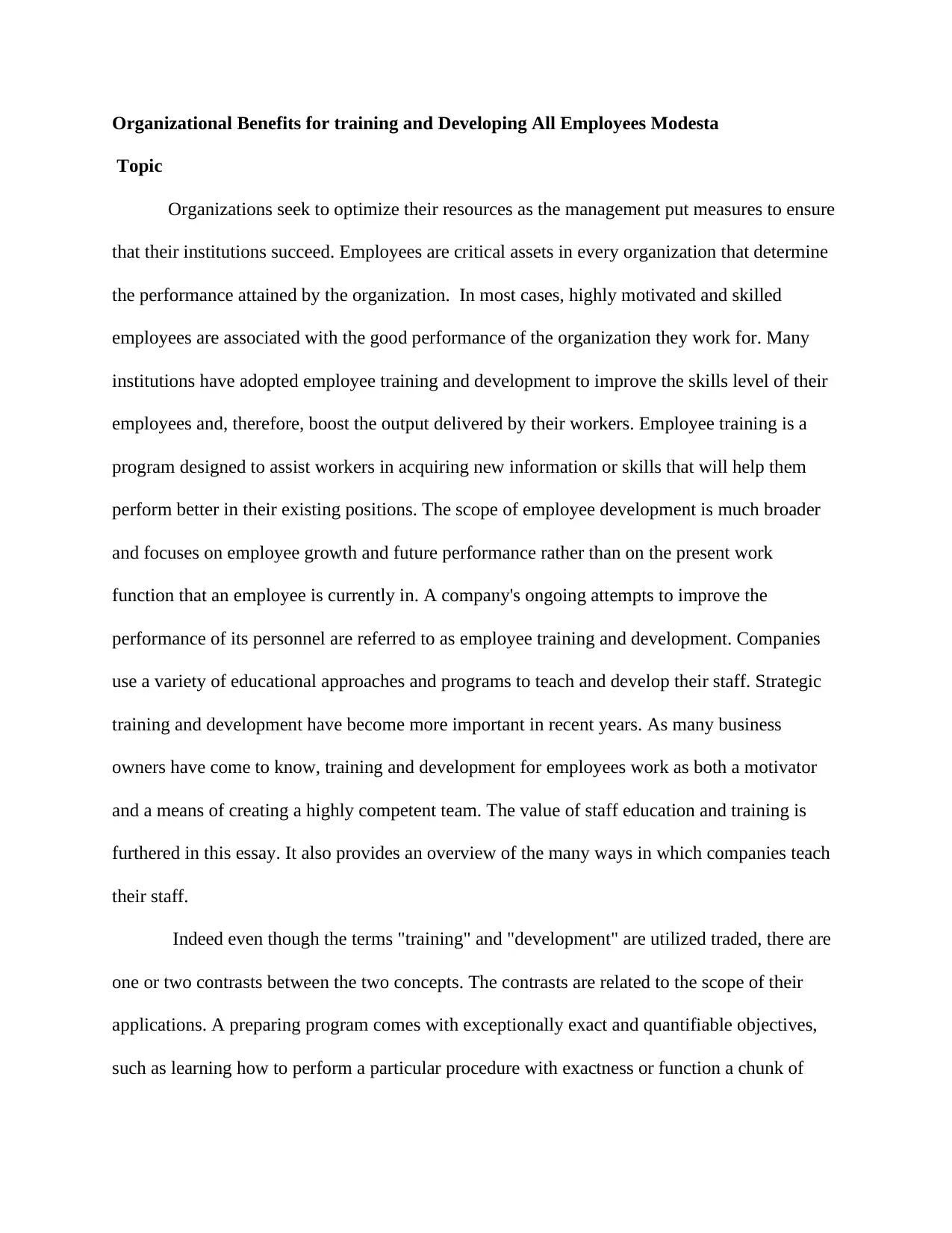
Organizational Benefits for training and Developing All Employees Modesta
Topic
Organizations seek to optimize their resources as the management put measures to ensure
that their institutions succeed. Employees are critical assets in every organization that determine
the performance attained by the organization. In most cases, highly motivated and skilled
employees are associated with the good performance of the organization they work for. Many
institutions have adopted employee training and development to improve the skills level of their
employees and, therefore, boost the output delivered by their workers. Employee training is a
program designed to assist workers in acquiring new information or skills that will help them
perform better in their existing positions. The scope of employee development is much broader
and focuses on employee growth and future performance rather than on the present work
function that an employee is currently in. A company's ongoing attempts to improve the
performance of its personnel are referred to as employee training and development. Companies
use a variety of educational approaches and programs to teach and develop their staff. Strategic
training and development have become more important in recent years. As many business
owners have come to know, training and development for employees work as both a motivator
and a means of creating a highly competent team. The value of staff education and training is
furthered in this essay. It also provides an overview of the many ways in which companies teach
their staff.
Indeed even though the terms "training" and "development" are utilized traded, there are
one or two contrasts between the two concepts. The contrasts are related to the scope of their
applications. A preparing program comes with exceptionally exact and quantifiable objectives,
such as learning how to perform a particular procedure with exactness or function a chunk of
Topic
Organizations seek to optimize their resources as the management put measures to ensure
that their institutions succeed. Employees are critical assets in every organization that determine
the performance attained by the organization. In most cases, highly motivated and skilled
employees are associated with the good performance of the organization they work for. Many
institutions have adopted employee training and development to improve the skills level of their
employees and, therefore, boost the output delivered by their workers. Employee training is a
program designed to assist workers in acquiring new information or skills that will help them
perform better in their existing positions. The scope of employee development is much broader
and focuses on employee growth and future performance rather than on the present work
function that an employee is currently in. A company's ongoing attempts to improve the
performance of its personnel are referred to as employee training and development. Companies
use a variety of educational approaches and programs to teach and develop their staff. Strategic
training and development have become more important in recent years. As many business
owners have come to know, training and development for employees work as both a motivator
and a means of creating a highly competent team. The value of staff education and training is
furthered in this essay. It also provides an overview of the many ways in which companies teach
their staff.
Indeed even though the terms "training" and "development" are utilized traded, there are
one or two contrasts between the two concepts. The contrasts are related to the scope of their
applications. A preparing program comes with exceptionally exact and quantifiable objectives,
such as learning how to perform a particular procedure with exactness or function a chunk of
Secure Best Marks with AI Grader
Need help grading? Try our AI Grader for instant feedback on your assignments.
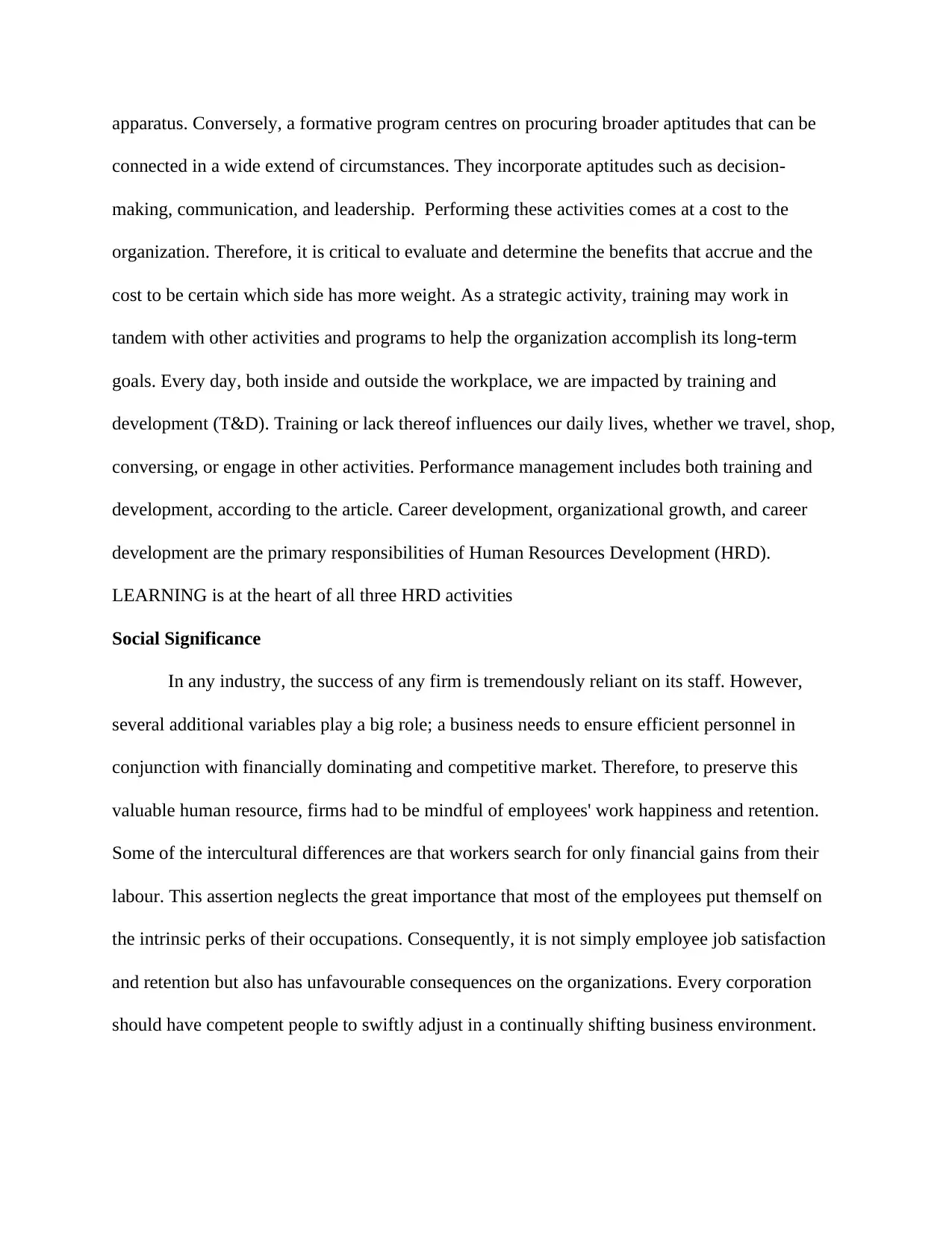
apparatus. Conversely, a formative program centres on procuring broader aptitudes that can be
connected in a wide extend of circumstances. They incorporate aptitudes such as decision-
making, communication, and leadership. Performing these activities comes at a cost to the
organization. Therefore, it is critical to evaluate and determine the benefits that accrue and the
cost to be certain which side has more weight. As a strategic activity, training may work in
tandem with other activities and programs to help the organization accomplish its long-term
goals. Every day, both inside and outside the workplace, we are impacted by training and
development (T&D). Training or lack thereof influences our daily lives, whether we travel, shop,
conversing, or engage in other activities. Performance management includes both training and
development, according to the article. Career development, organizational growth, and career
development are the primary responsibilities of Human Resources Development (HRD).
LEARNING is at the heart of all three HRD activities
Social Significance
In any industry, the success of any firm is tremendously reliant on its staff. However,
several additional variables play a big role; a business needs to ensure efficient personnel in
conjunction with financially dominating and competitive market. Therefore, to preserve this
valuable human resource, firms had to be mindful of employees' work happiness and retention.
Some of the intercultural differences are that workers search for only financial gains from their
labour. This assertion neglects the great importance that most of the employees put themself on
the intrinsic perks of their occupations. Consequently, it is not simply employee job satisfaction
and retention but also has unfavourable consequences on the organizations. Every corporation
should have competent people to swiftly adjust in a continually shifting business environment.
connected in a wide extend of circumstances. They incorporate aptitudes such as decision-
making, communication, and leadership. Performing these activities comes at a cost to the
organization. Therefore, it is critical to evaluate and determine the benefits that accrue and the
cost to be certain which side has more weight. As a strategic activity, training may work in
tandem with other activities and programs to help the organization accomplish its long-term
goals. Every day, both inside and outside the workplace, we are impacted by training and
development (T&D). Training or lack thereof influences our daily lives, whether we travel, shop,
conversing, or engage in other activities. Performance management includes both training and
development, according to the article. Career development, organizational growth, and career
development are the primary responsibilities of Human Resources Development (HRD).
LEARNING is at the heart of all three HRD activities
Social Significance
In any industry, the success of any firm is tremendously reliant on its staff. However,
several additional variables play a big role; a business needs to ensure efficient personnel in
conjunction with financially dominating and competitive market. Therefore, to preserve this
valuable human resource, firms had to be mindful of employees' work happiness and retention.
Some of the intercultural differences are that workers search for only financial gains from their
labour. This assertion neglects the great importance that most of the employees put themself on
the intrinsic perks of their occupations. Consequently, it is not simply employee job satisfaction
and retention but also has unfavourable consequences on the organizations. Every corporation
should have competent people to swiftly adjust in a continually shifting business environment.
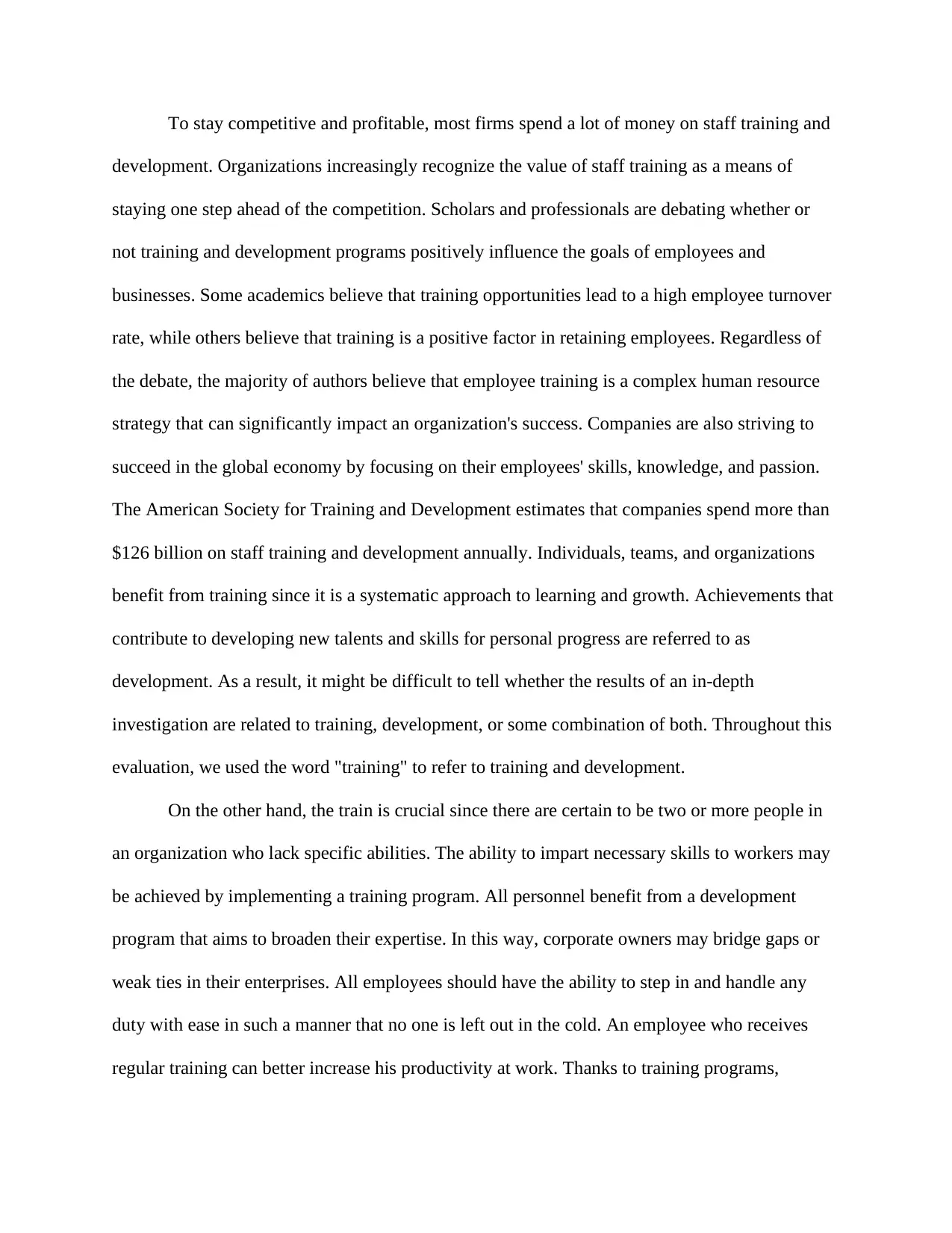
To stay competitive and profitable, most firms spend a lot of money on staff training and
development. Organizations increasingly recognize the value of staff training as a means of
staying one step ahead of the competition. Scholars and professionals are debating whether or
not training and development programs positively influence the goals of employees and
businesses. Some academics believe that training opportunities lead to a high employee turnover
rate, while others believe that training is a positive factor in retaining employees. Regardless of
the debate, the majority of authors believe that employee training is a complex human resource
strategy that can significantly impact an organization's success. Companies are also striving to
succeed in the global economy by focusing on their employees' skills, knowledge, and passion.
The American Society for Training and Development estimates that companies spend more than
$126 billion on staff training and development annually. Individuals, teams, and organizations
benefit from training since it is a systematic approach to learning and growth. Achievements that
contribute to developing new talents and skills for personal progress are referred to as
development. As a result, it might be difficult to tell whether the results of an in-depth
investigation are related to training, development, or some combination of both. Throughout this
evaluation, we used the word "training" to refer to training and development.
On the other hand, the train is crucial since there are certain to be two or more people in
an organization who lack specific abilities. The ability to impart necessary skills to workers may
be achieved by implementing a training program. All personnel benefit from a development
program that aims to broaden their expertise. In this way, corporate owners may bridge gaps or
weak ties in their enterprises. All employees should have the ability to step in and handle any
duty with ease in such a manner that no one is left out in the cold. An employee who receives
regular training can better increase his productivity at work. Thanks to training programs,
development. Organizations increasingly recognize the value of staff training as a means of
staying one step ahead of the competition. Scholars and professionals are debating whether or
not training and development programs positively influence the goals of employees and
businesses. Some academics believe that training opportunities lead to a high employee turnover
rate, while others believe that training is a positive factor in retaining employees. Regardless of
the debate, the majority of authors believe that employee training is a complex human resource
strategy that can significantly impact an organization's success. Companies are also striving to
succeed in the global economy by focusing on their employees' skills, knowledge, and passion.
The American Society for Training and Development estimates that companies spend more than
$126 billion on staff training and development annually. Individuals, teams, and organizations
benefit from training since it is a systematic approach to learning and growth. Achievements that
contribute to developing new talents and skills for personal progress are referred to as
development. As a result, it might be difficult to tell whether the results of an in-depth
investigation are related to training, development, or some combination of both. Throughout this
evaluation, we used the word "training" to refer to training and development.
On the other hand, the train is crucial since there are certain to be two or more people in
an organization who lack specific abilities. The ability to impart necessary skills to workers may
be achieved by implementing a training program. All personnel benefit from a development
program that aims to broaden their expertise. In this way, corporate owners may bridge gaps or
weak ties in their enterprises. All employees should have the ability to step in and handle any
duty with ease in such a manner that no one is left out in the cold. An employee who receives
regular training can better increase his productivity at work. Thanks to training programs,
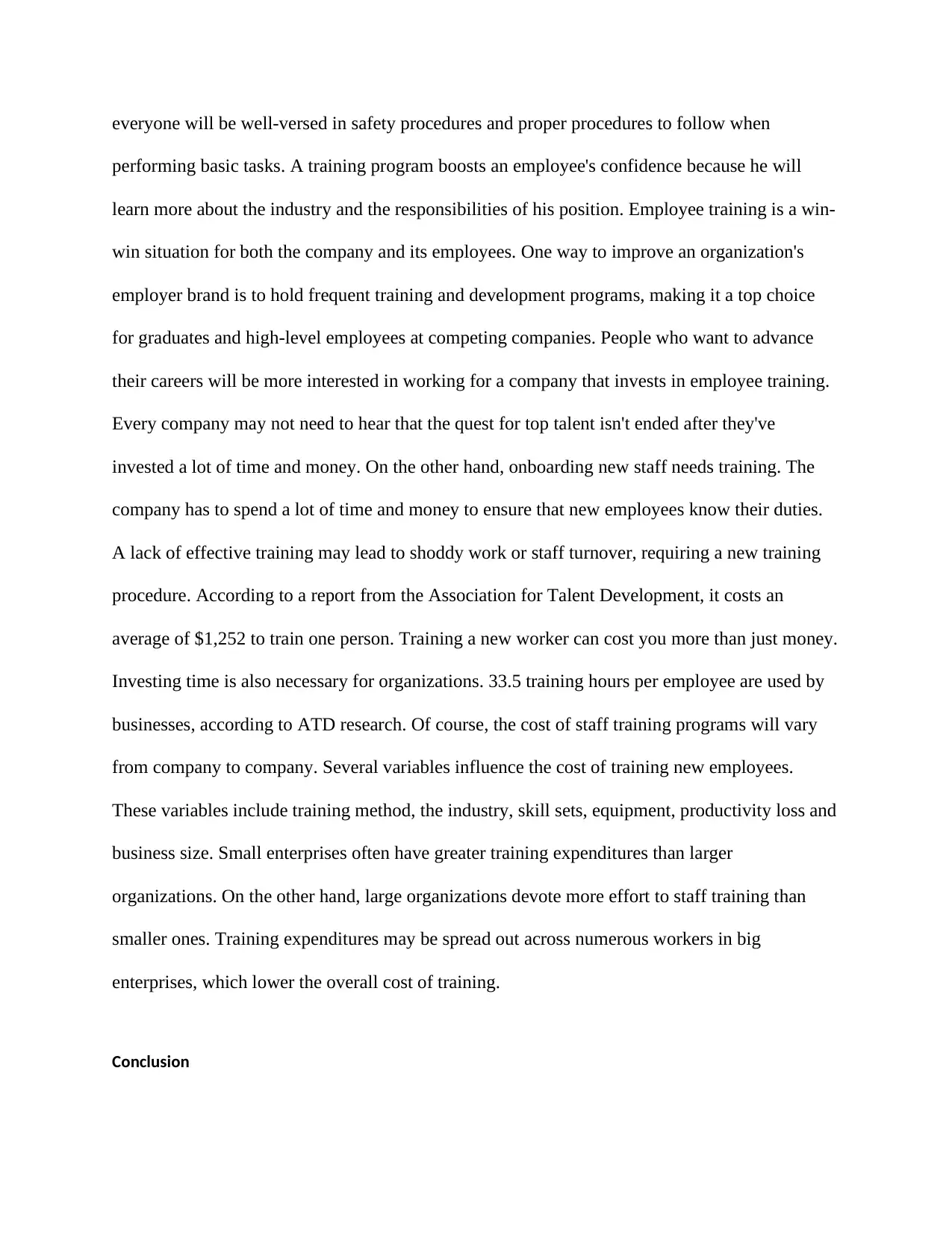
everyone will be well-versed in safety procedures and proper procedures to follow when
performing basic tasks. A training program boosts an employee's confidence because he will
learn more about the industry and the responsibilities of his position. Employee training is a win-
win situation for both the company and its employees. One way to improve an organization's
employer brand is to hold frequent training and development programs, making it a top choice
for graduates and high-level employees at competing companies. People who want to advance
their careers will be more interested in working for a company that invests in employee training.
Every company may not need to hear that the quest for top talent isn't ended after they've
invested a lot of time and money. On the other hand, onboarding new staff needs training. The
company has to spend a lot of time and money to ensure that new employees know their duties.
A lack of effective training may lead to shoddy work or staff turnover, requiring a new training
procedure. According to a report from the Association for Talent Development, it costs an
average of $1,252 to train one person. Training a new worker can cost you more than just money.
Investing time is also necessary for organizations. 33.5 training hours per employee are used by
businesses, according to ATD research. Of course, the cost of staff training programs will vary
from company to company. Several variables influence the cost of training new employees.
These variables include training method, the industry, skill sets, equipment, productivity loss and
business size. Small enterprises often have greater training expenditures than larger
organizations. On the other hand, large organizations devote more effort to staff training than
smaller ones. Training expenditures may be spread out across numerous workers in big
enterprises, which lower the overall cost of training.
Conclusion
performing basic tasks. A training program boosts an employee's confidence because he will
learn more about the industry and the responsibilities of his position. Employee training is a win-
win situation for both the company and its employees. One way to improve an organization's
employer brand is to hold frequent training and development programs, making it a top choice
for graduates and high-level employees at competing companies. People who want to advance
their careers will be more interested in working for a company that invests in employee training.
Every company may not need to hear that the quest for top talent isn't ended after they've
invested a lot of time and money. On the other hand, onboarding new staff needs training. The
company has to spend a lot of time and money to ensure that new employees know their duties.
A lack of effective training may lead to shoddy work or staff turnover, requiring a new training
procedure. According to a report from the Association for Talent Development, it costs an
average of $1,252 to train one person. Training a new worker can cost you more than just money.
Investing time is also necessary for organizations. 33.5 training hours per employee are used by
businesses, according to ATD research. Of course, the cost of staff training programs will vary
from company to company. Several variables influence the cost of training new employees.
These variables include training method, the industry, skill sets, equipment, productivity loss and
business size. Small enterprises often have greater training expenditures than larger
organizations. On the other hand, large organizations devote more effort to staff training than
smaller ones. Training expenditures may be spread out across numerous workers in big
enterprises, which lower the overall cost of training.
Conclusion
Secure Best Marks with AI Grader
Need help grading? Try our AI Grader for instant feedback on your assignments.
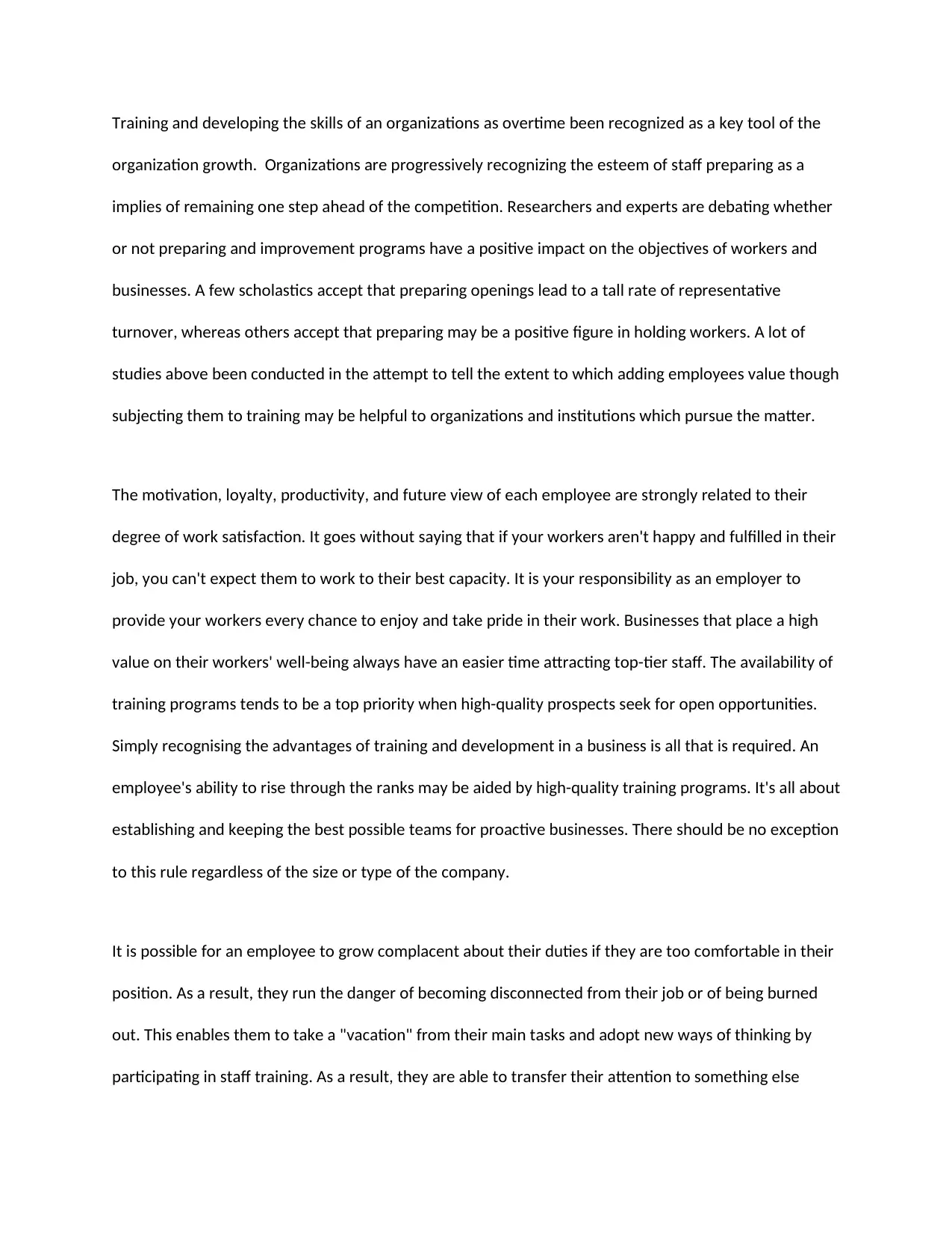
Training and developing the skills of an organizations as overtime been recognized as a key tool of the
organization growth. Organizations are progressively recognizing the esteem of staff preparing as a
implies of remaining one step ahead of the competition. Researchers and experts are debating whether
or not preparing and improvement programs have a positive impact on the objectives of workers and
businesses. A few scholastics accept that preparing openings lead to a tall rate of representative
turnover, whereas others accept that preparing may be a positive figure in holding workers. A lot of
studies above been conducted in the attempt to tell the extent to which adding employees value though
subjecting them to training may be helpful to organizations and institutions which pursue the matter.
The motivation, loyalty, productivity, and future view of each employee are strongly related to their
degree of work satisfaction. It goes without saying that if your workers aren't happy and fulfilled in their
job, you can't expect them to work to their best capacity. It is your responsibility as an employer to
provide your workers every chance to enjoy and take pride in their work. Businesses that place a high
value on their workers' well-being always have an easier time attracting top-tier staff. The availability of
training programs tends to be a top priority when high-quality prospects seek for open opportunities.
Simply recognising the advantages of training and development in a business is all that is required. An
employee's ability to rise through the ranks may be aided by high-quality training programs. It's all about
establishing and keeping the best possible teams for proactive businesses. There should be no exception
to this rule regardless of the size or type of the company.
It is possible for an employee to grow complacent about their duties if they are too comfortable in their
position. As a result, they run the danger of becoming disconnected from their job or of being burned
out. This enables them to take a "vacation" from their main tasks and adopt new ways of thinking by
participating in staff training. As a result, they are able to transfer their attention to something else
organization growth. Organizations are progressively recognizing the esteem of staff preparing as a
implies of remaining one step ahead of the competition. Researchers and experts are debating whether
or not preparing and improvement programs have a positive impact on the objectives of workers and
businesses. A few scholastics accept that preparing openings lead to a tall rate of representative
turnover, whereas others accept that preparing may be a positive figure in holding workers. A lot of
studies above been conducted in the attempt to tell the extent to which adding employees value though
subjecting them to training may be helpful to organizations and institutions which pursue the matter.
The motivation, loyalty, productivity, and future view of each employee are strongly related to their
degree of work satisfaction. It goes without saying that if your workers aren't happy and fulfilled in their
job, you can't expect them to work to their best capacity. It is your responsibility as an employer to
provide your workers every chance to enjoy and take pride in their work. Businesses that place a high
value on their workers' well-being always have an easier time attracting top-tier staff. The availability of
training programs tends to be a top priority when high-quality prospects seek for open opportunities.
Simply recognising the advantages of training and development in a business is all that is required. An
employee's ability to rise through the ranks may be aided by high-quality training programs. It's all about
establishing and keeping the best possible teams for proactive businesses. There should be no exception
to this rule regardless of the size or type of the company.
It is possible for an employee to grow complacent about their duties if they are too comfortable in their
position. As a result, they run the danger of becoming disconnected from their job or of being burned
out. This enables them to take a "vacation" from their main tasks and adopt new ways of thinking by
participating in staff training. As a result, they are able to transfer their attention to something else
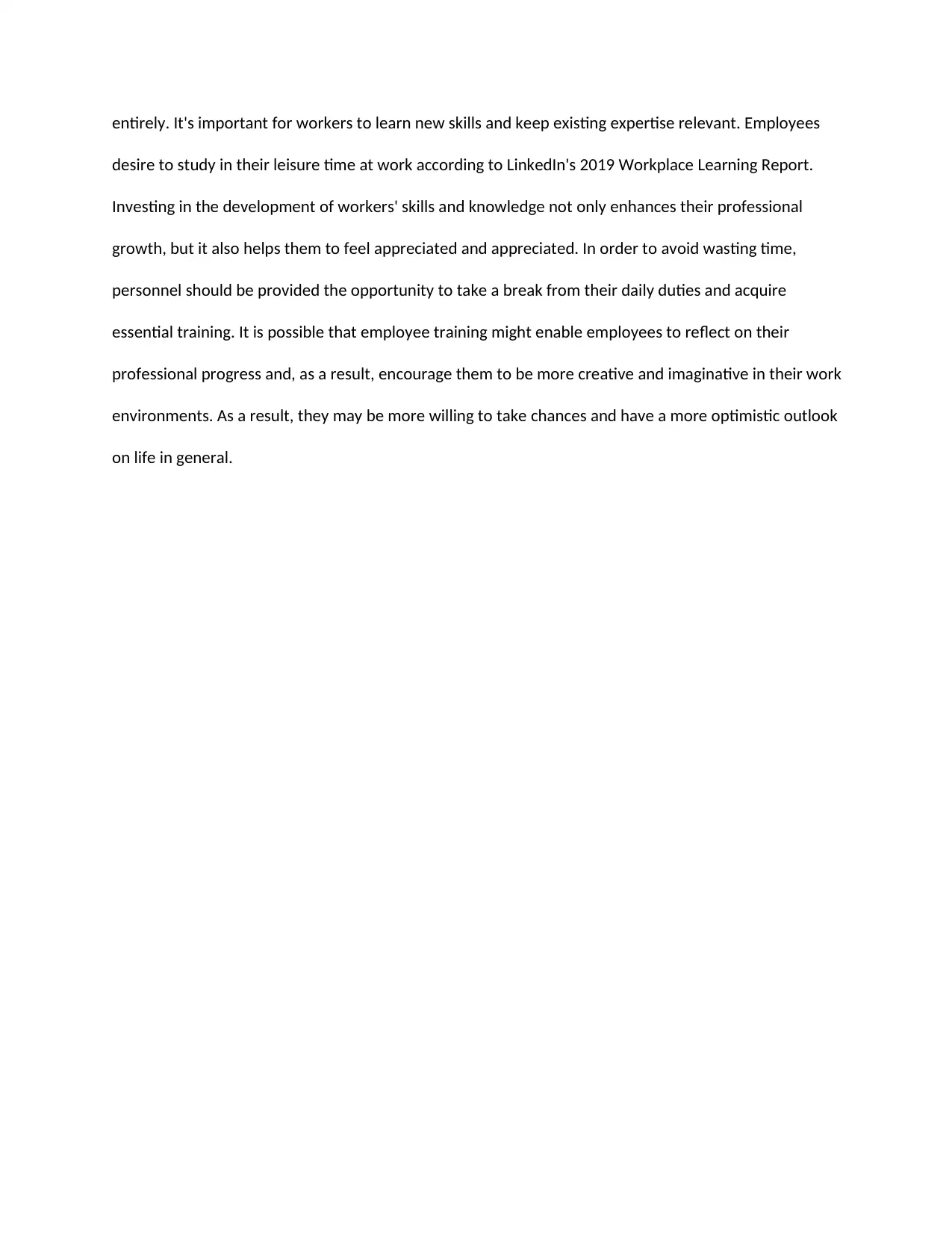
entirely. It's important for workers to learn new skills and keep existing expertise relevant. Employees
desire to study in their leisure time at work according to LinkedIn's 2019 Workplace Learning Report.
Investing in the development of workers' skills and knowledge not only enhances their professional
growth, but it also helps them to feel appreciated and appreciated. In order to avoid wasting time,
personnel should be provided the opportunity to take a break from their daily duties and acquire
essential training. It is possible that employee training might enable employees to reflect on their
professional progress and, as a result, encourage them to be more creative and imaginative in their work
environments. As a result, they may be more willing to take chances and have a more optimistic outlook
on life in general.
desire to study in their leisure time at work according to LinkedIn's 2019 Workplace Learning Report.
Investing in the development of workers' skills and knowledge not only enhances their professional
growth, but it also helps them to feel appreciated and appreciated. In order to avoid wasting time,
personnel should be provided the opportunity to take a break from their daily duties and acquire
essential training. It is possible that employee training might enable employees to reflect on their
professional progress and, as a result, encourage them to be more creative and imaginative in their work
environments. As a result, they may be more willing to take chances and have a more optimistic outlook
on life in general.
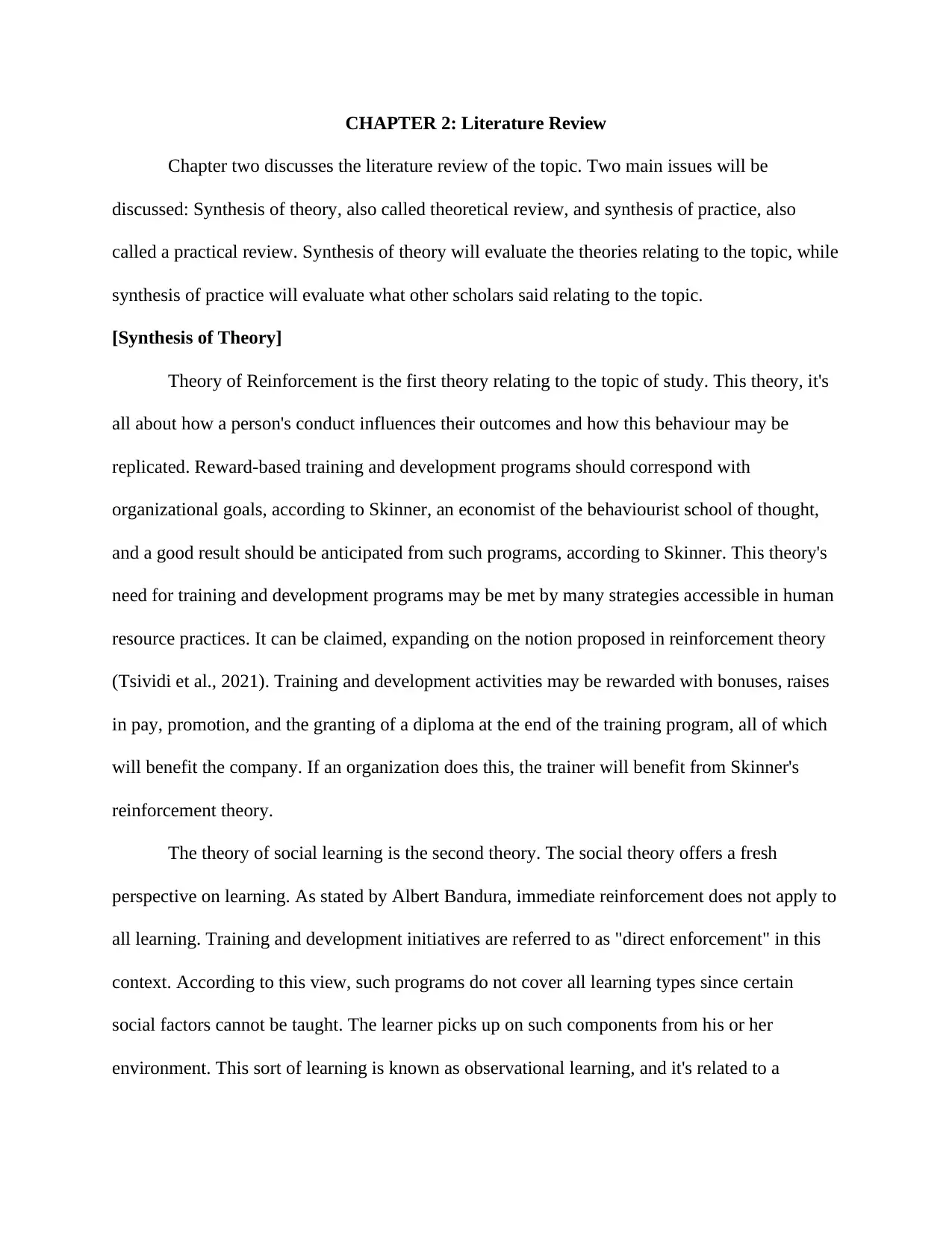
CHAPTER 2: Literature Review
Chapter two discusses the literature review of the topic. Two main issues will be
discussed: Synthesis of theory, also called theoretical review, and synthesis of practice, also
called a practical review. Synthesis of theory will evaluate the theories relating to the topic, while
synthesis of practice will evaluate what other scholars said relating to the topic.
[Synthesis of Theory]
Theory of Reinforcement is the first theory relating to the topic of study. This theory, it's
all about how a person's conduct influences their outcomes and how this behaviour may be
replicated. Reward-based training and development programs should correspond with
organizational goals, according to Skinner, an economist of the behaviourist school of thought,
and a good result should be anticipated from such programs, according to Skinner. This theory's
need for training and development programs may be met by many strategies accessible in human
resource practices. It can be claimed, expanding on the notion proposed in reinforcement theory
(Tsividi et al., 2021). Training and development activities may be rewarded with bonuses, raises
in pay, promotion, and the granting of a diploma at the end of the training program, all of which
will benefit the company. If an organization does this, the trainer will benefit from Skinner's
reinforcement theory.
The theory of social learning is the second theory. The social theory offers a fresh
perspective on learning. As stated by Albert Bandura, immediate reinforcement does not apply to
all learning. Training and development initiatives are referred to as "direct enforcement" in this
context. According to this view, such programs do not cover all learning types since certain
social factors cannot be taught. The learner picks up on such components from his or her
environment. This sort of learning is known as observational learning, and it's related to a
Chapter two discusses the literature review of the topic. Two main issues will be
discussed: Synthesis of theory, also called theoretical review, and synthesis of practice, also
called a practical review. Synthesis of theory will evaluate the theories relating to the topic, while
synthesis of practice will evaluate what other scholars said relating to the topic.
[Synthesis of Theory]
Theory of Reinforcement is the first theory relating to the topic of study. This theory, it's
all about how a person's conduct influences their outcomes and how this behaviour may be
replicated. Reward-based training and development programs should correspond with
organizational goals, according to Skinner, an economist of the behaviourist school of thought,
and a good result should be anticipated from such programs, according to Skinner. This theory's
need for training and development programs may be met by many strategies accessible in human
resource practices. It can be claimed, expanding on the notion proposed in reinforcement theory
(Tsividi et al., 2021). Training and development activities may be rewarded with bonuses, raises
in pay, promotion, and the granting of a diploma at the end of the training program, all of which
will benefit the company. If an organization does this, the trainer will benefit from Skinner's
reinforcement theory.
The theory of social learning is the second theory. The social theory offers a fresh
perspective on learning. As stated by Albert Bandura, immediate reinforcement does not apply to
all learning. Training and development initiatives are referred to as "direct enforcement" in this
context. According to this view, such programs do not cover all learning types since certain
social factors cannot be taught. The learner picks up on such components from his or her
environment. This sort of learning is known as observational learning, and it's related to a
Paraphrase This Document
Need a fresh take? Get an instant paraphrase of this document with our AI Paraphraser
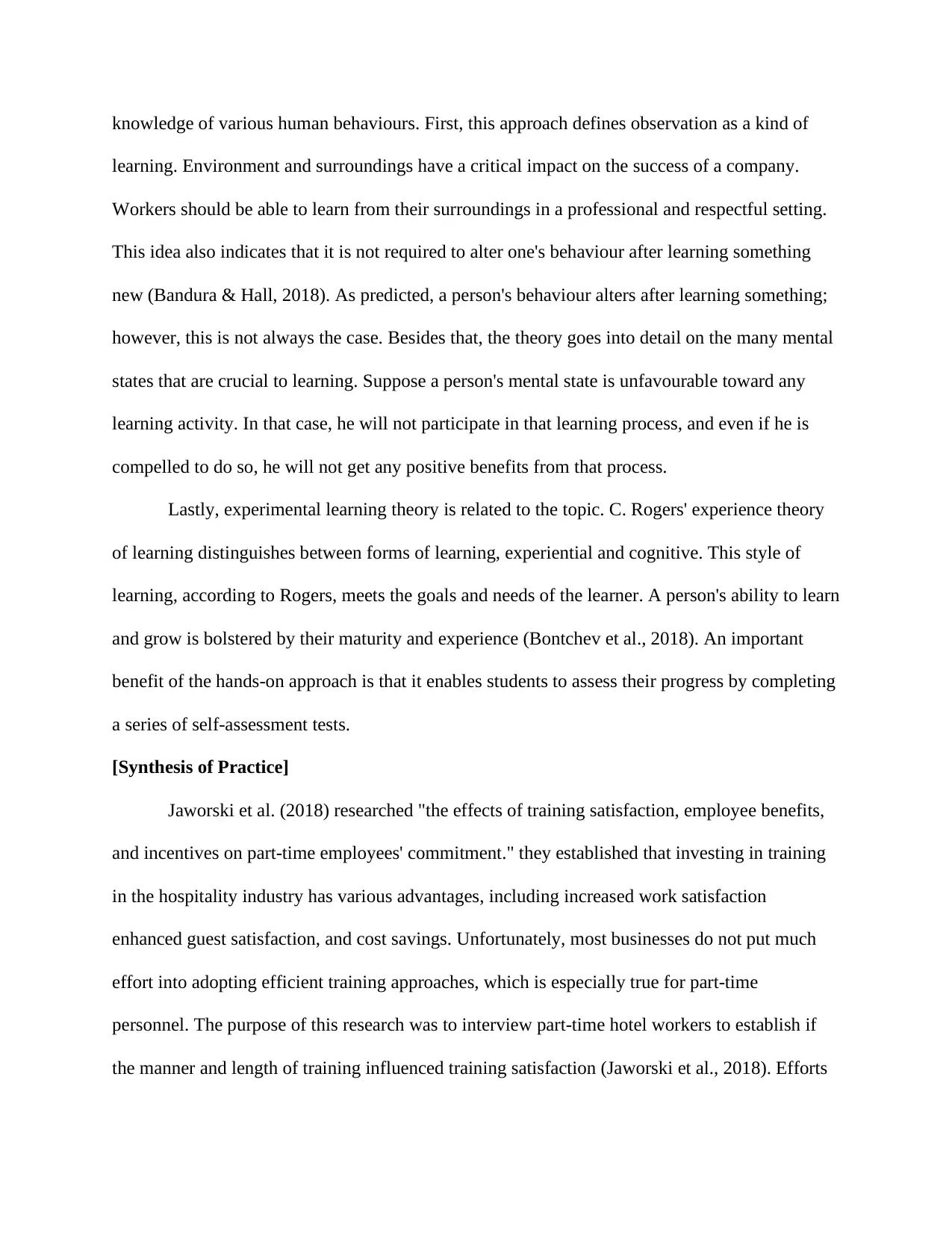
knowledge of various human behaviours. First, this approach defines observation as a kind of
learning. Environment and surroundings have a critical impact on the success of a company.
Workers should be able to learn from their surroundings in a professional and respectful setting.
This idea also indicates that it is not required to alter one's behaviour after learning something
new (Bandura & Hall, 2018). As predicted, a person's behaviour alters after learning something;
however, this is not always the case. Besides that, the theory goes into detail on the many mental
states that are crucial to learning. Suppose a person's mental state is unfavourable toward any
learning activity. In that case, he will not participate in that learning process, and even if he is
compelled to do so, he will not get any positive benefits from that process.
Lastly, experimental learning theory is related to the topic. C. Rogers' experience theory
of learning distinguishes between forms of learning, experiential and cognitive. This style of
learning, according to Rogers, meets the goals and needs of the learner. A person's ability to learn
and grow is bolstered by their maturity and experience (Bontchev et al., 2018). An important
benefit of the hands-on approach is that it enables students to assess their progress by completing
a series of self-assessment tests.
[Synthesis of Practice]
Jaworski et al. (2018) researched "the effects of training satisfaction, employee benefits,
and incentives on part-time employees' commitment." they established that investing in training
in the hospitality industry has various advantages, including increased work satisfaction
enhanced guest satisfaction, and cost savings. Unfortunately, most businesses do not put much
effort into adopting efficient training approaches, which is especially true for part-time
personnel. The purpose of this research was to interview part-time hotel workers to establish if
the manner and length of training influenced training satisfaction (Jaworski et al., 2018). Efforts
learning. Environment and surroundings have a critical impact on the success of a company.
Workers should be able to learn from their surroundings in a professional and respectful setting.
This idea also indicates that it is not required to alter one's behaviour after learning something
new (Bandura & Hall, 2018). As predicted, a person's behaviour alters after learning something;
however, this is not always the case. Besides that, the theory goes into detail on the many mental
states that are crucial to learning. Suppose a person's mental state is unfavourable toward any
learning activity. In that case, he will not participate in that learning process, and even if he is
compelled to do so, he will not get any positive benefits from that process.
Lastly, experimental learning theory is related to the topic. C. Rogers' experience theory
of learning distinguishes between forms of learning, experiential and cognitive. This style of
learning, according to Rogers, meets the goals and needs of the learner. A person's ability to learn
and grow is bolstered by their maturity and experience (Bontchev et al., 2018). An important
benefit of the hands-on approach is that it enables students to assess their progress by completing
a series of self-assessment tests.
[Synthesis of Practice]
Jaworski et al. (2018) researched "the effects of training satisfaction, employee benefits,
and incentives on part-time employees' commitment." they established that investing in training
in the hospitality industry has various advantages, including increased work satisfaction
enhanced guest satisfaction, and cost savings. Unfortunately, most businesses do not put much
effort into adopting efficient training approaches, which is especially true for part-time
personnel. The purpose of this research was to interview part-time hotel workers to establish if
the manner and length of training influenced training satisfaction (Jaworski et al., 2018). Efforts
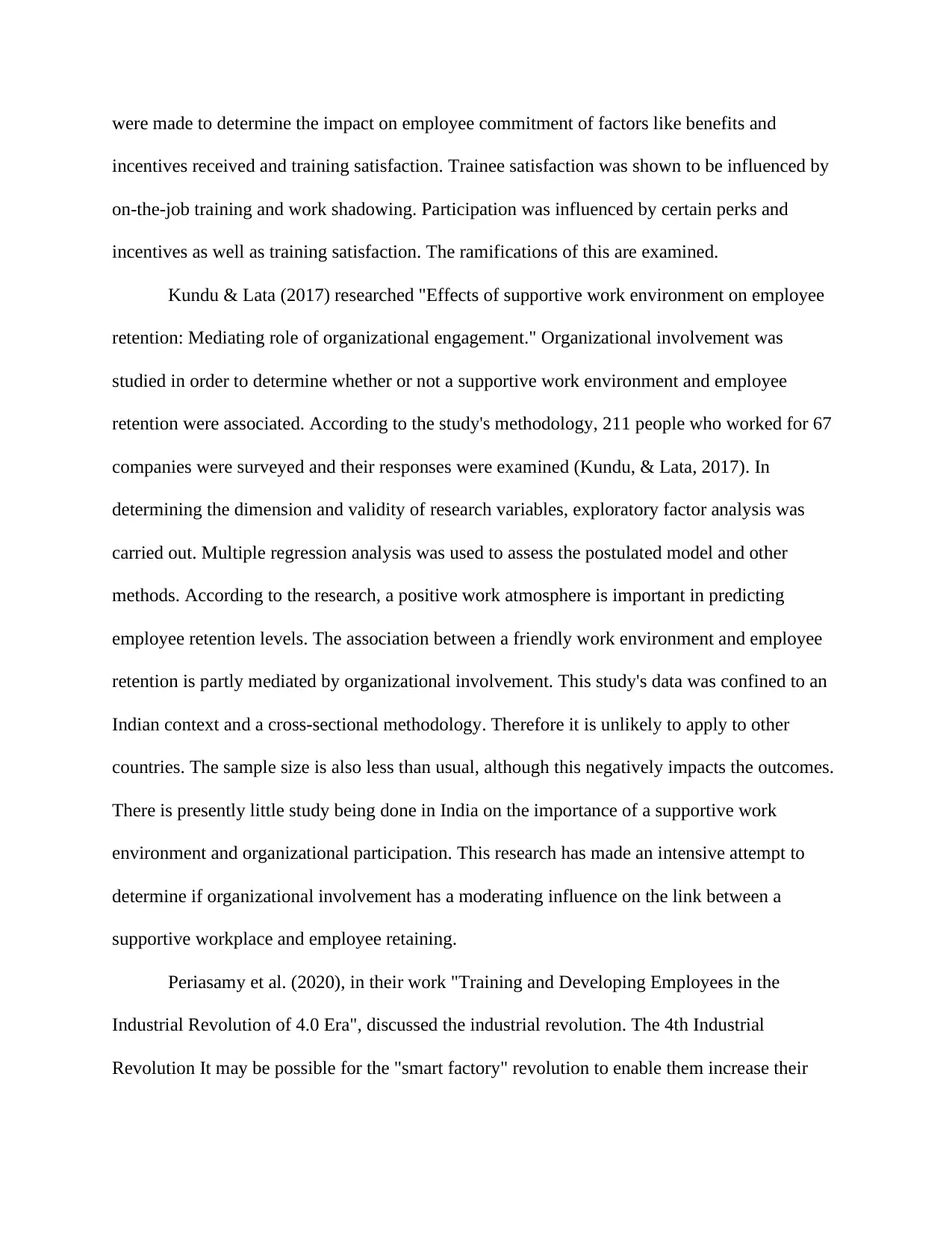
were made to determine the impact on employee commitment of factors like benefits and
incentives received and training satisfaction. Trainee satisfaction was shown to be influenced by
on-the-job training and work shadowing. Participation was influenced by certain perks and
incentives as well as training satisfaction. The ramifications of this are examined.
Kundu & Lata (2017) researched "Effects of supportive work environment on employee
retention: Mediating role of organizational engagement." Organizational involvement was
studied in order to determine whether or not a supportive work environment and employee
retention were associated. According to the study's methodology, 211 people who worked for 67
companies were surveyed and their responses were examined (Kundu, & Lata, 2017). In
determining the dimension and validity of research variables, exploratory factor analysis was
carried out. Multiple regression analysis was used to assess the postulated model and other
methods. According to the research, a positive work atmosphere is important in predicting
employee retention levels. The association between a friendly work environment and employee
retention is partly mediated by organizational involvement. This study's data was confined to an
Indian context and a cross-sectional methodology. Therefore it is unlikely to apply to other
countries. The sample size is also less than usual, although this negatively impacts the outcomes.
There is presently little study being done in India on the importance of a supportive work
environment and organizational participation. This research has made an intensive attempt to
determine if organizational involvement has a moderating influence on the link between a
supportive workplace and employee retaining.
Periasamy et al. (2020), in their work "Training and Developing Employees in the
Industrial Revolution of 4.0 Era", discussed the industrial revolution. The 4th Industrial
Revolution It may be possible for the "smart factory" revolution to enable them increase their
incentives received and training satisfaction. Trainee satisfaction was shown to be influenced by
on-the-job training and work shadowing. Participation was influenced by certain perks and
incentives as well as training satisfaction. The ramifications of this are examined.
Kundu & Lata (2017) researched "Effects of supportive work environment on employee
retention: Mediating role of organizational engagement." Organizational involvement was
studied in order to determine whether or not a supportive work environment and employee
retention were associated. According to the study's methodology, 211 people who worked for 67
companies were surveyed and their responses were examined (Kundu, & Lata, 2017). In
determining the dimension and validity of research variables, exploratory factor analysis was
carried out. Multiple regression analysis was used to assess the postulated model and other
methods. According to the research, a positive work atmosphere is important in predicting
employee retention levels. The association between a friendly work environment and employee
retention is partly mediated by organizational involvement. This study's data was confined to an
Indian context and a cross-sectional methodology. Therefore it is unlikely to apply to other
countries. The sample size is also less than usual, although this negatively impacts the outcomes.
There is presently little study being done in India on the importance of a supportive work
environment and organizational participation. This research has made an intensive attempt to
determine if organizational involvement has a moderating influence on the link between a
supportive workplace and employee retaining.
Periasamy et al. (2020), in their work "Training and Developing Employees in the
Industrial Revolution of 4.0 Era", discussed the industrial revolution. The 4th Industrial
Revolution It may be possible for the "smart factory" revolution to enable them increase their
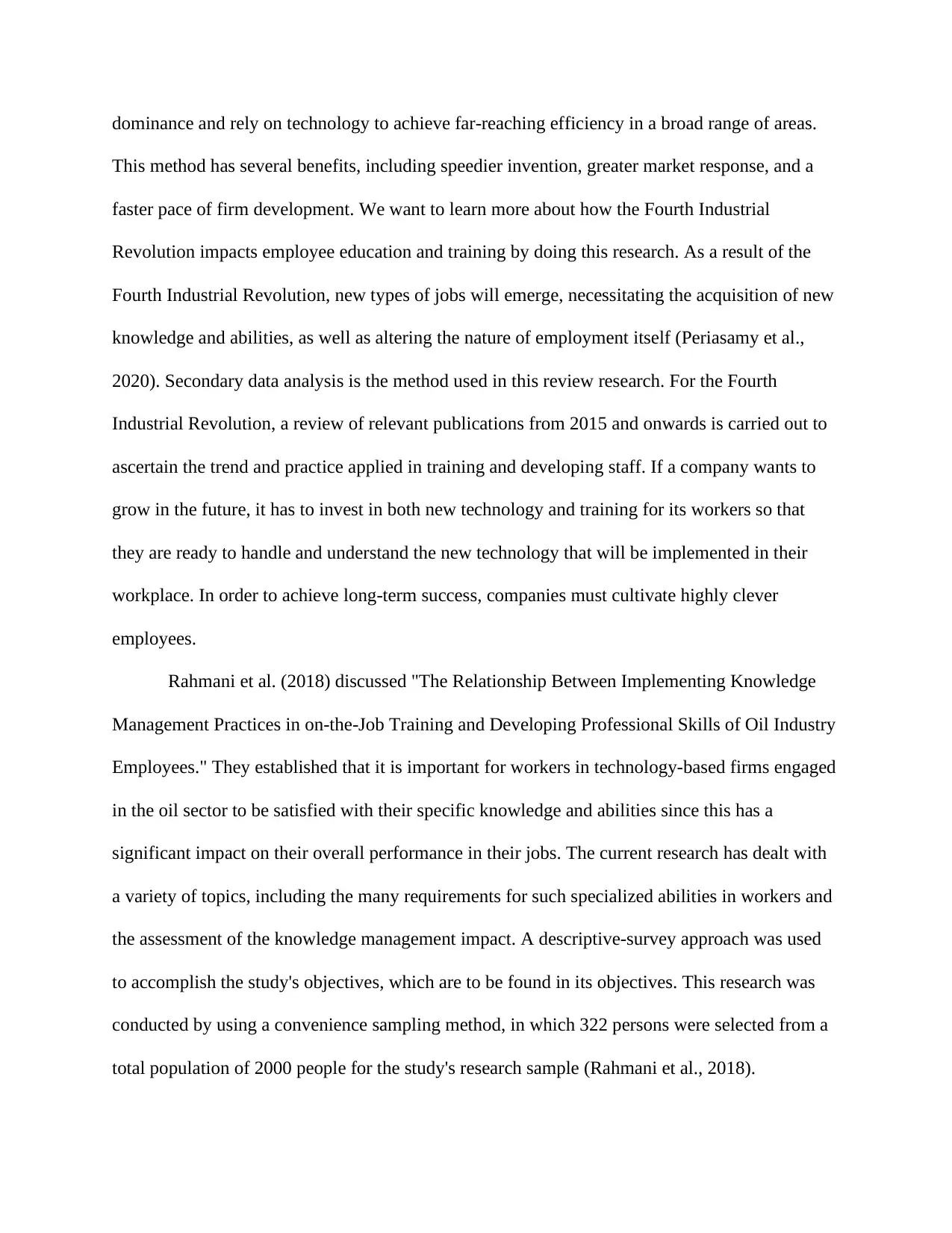
dominance and rely on technology to achieve far-reaching efficiency in a broad range of areas.
This method has several benefits, including speedier invention, greater market response, and a
faster pace of firm development. We want to learn more about how the Fourth Industrial
Revolution impacts employee education and training by doing this research. As a result of the
Fourth Industrial Revolution, new types of jobs will emerge, necessitating the acquisition of new
knowledge and abilities, as well as altering the nature of employment itself (Periasamy et al.,
2020). Secondary data analysis is the method used in this review research. For the Fourth
Industrial Revolution, a review of relevant publications from 2015 and onwards is carried out to
ascertain the trend and practice applied in training and developing staff. If a company wants to
grow in the future, it has to invest in both new technology and training for its workers so that
they are ready to handle and understand the new technology that will be implemented in their
workplace. In order to achieve long-term success, companies must cultivate highly clever
employees.
Rahmani et al. (2018) discussed "The Relationship Between Implementing Knowledge
Management Practices in on-the-Job Training and Developing Professional Skills of Oil Industry
Employees." They established that it is important for workers in technology-based firms engaged
in the oil sector to be satisfied with their specific knowledge and abilities since this has a
significant impact on their overall performance in their jobs. The current research has dealt with
a variety of topics, including the many requirements for such specialized abilities in workers and
the assessment of the knowledge management impact. A descriptive-survey approach was used
to accomplish the study's objectives, which are to be found in its objectives. This research was
conducted by using a convenience sampling method, in which 322 persons were selected from a
total population of 2000 people for the study's research sample (Rahmani et al., 2018).
This method has several benefits, including speedier invention, greater market response, and a
faster pace of firm development. We want to learn more about how the Fourth Industrial
Revolution impacts employee education and training by doing this research. As a result of the
Fourth Industrial Revolution, new types of jobs will emerge, necessitating the acquisition of new
knowledge and abilities, as well as altering the nature of employment itself (Periasamy et al.,
2020). Secondary data analysis is the method used in this review research. For the Fourth
Industrial Revolution, a review of relevant publications from 2015 and onwards is carried out to
ascertain the trend and practice applied in training and developing staff. If a company wants to
grow in the future, it has to invest in both new technology and training for its workers so that
they are ready to handle and understand the new technology that will be implemented in their
workplace. In order to achieve long-term success, companies must cultivate highly clever
employees.
Rahmani et al. (2018) discussed "The Relationship Between Implementing Knowledge
Management Practices in on-the-Job Training and Developing Professional Skills of Oil Industry
Employees." They established that it is important for workers in technology-based firms engaged
in the oil sector to be satisfied with their specific knowledge and abilities since this has a
significant impact on their overall performance in their jobs. The current research has dealt with
a variety of topics, including the many requirements for such specialized abilities in workers and
the assessment of the knowledge management impact. A descriptive-survey approach was used
to accomplish the study's objectives, which are to be found in its objectives. This research was
conducted by using a convenience sampling method, in which 322 persons were selected from a
total population of 2000 people for the study's research sample (Rahmani et al., 2018).
Secure Best Marks with AI Grader
Need help grading? Try our AI Grader for instant feedback on your assignments.
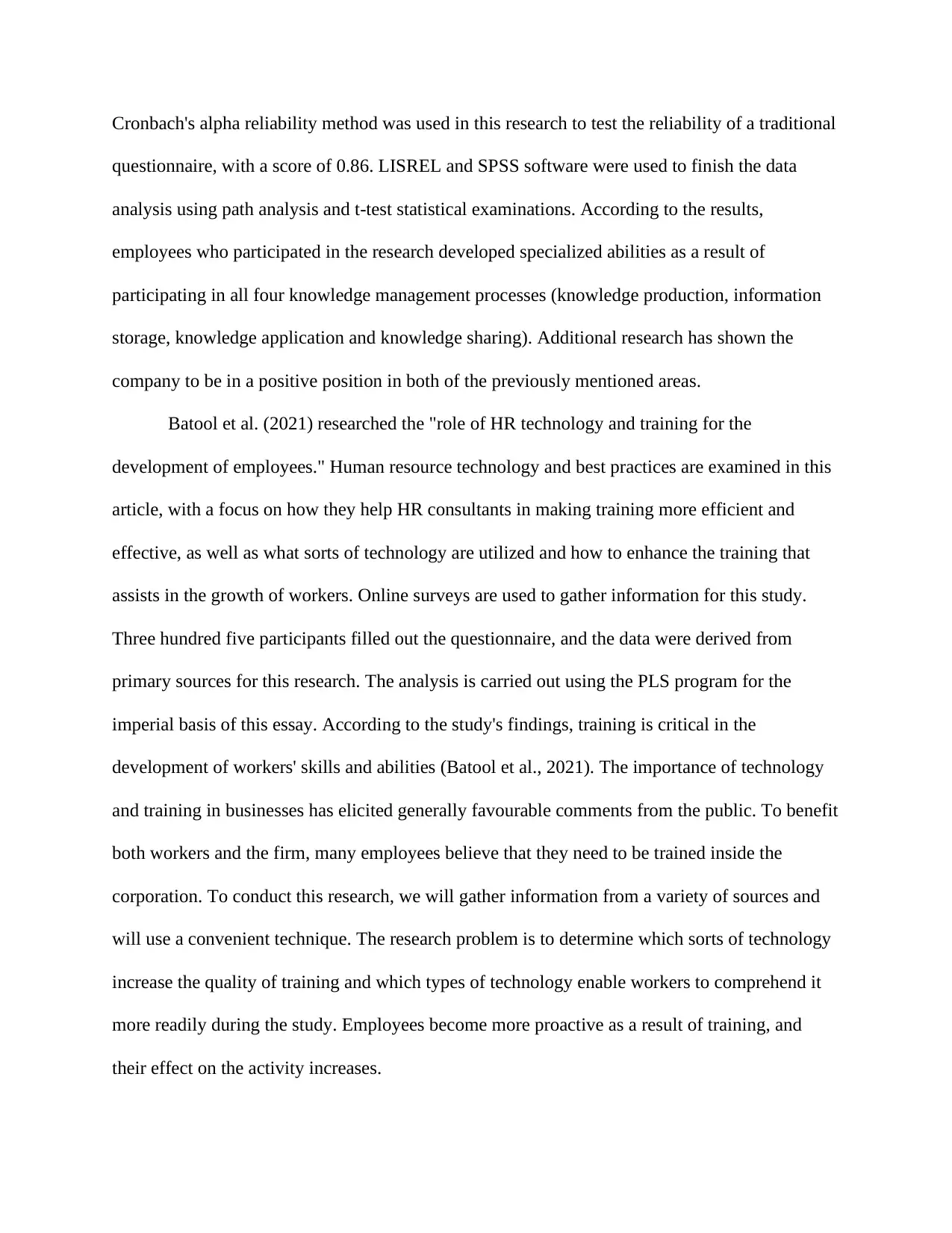
Cronbach's alpha reliability method was used in this research to test the reliability of a traditional
questionnaire, with a score of 0.86. LISREL and SPSS software were used to finish the data
analysis using path analysis and t-test statistical examinations. According to the results,
employees who participated in the research developed specialized abilities as a result of
participating in all four knowledge management processes (knowledge production, information
storage, knowledge application and knowledge sharing). Additional research has shown the
company to be in a positive position in both of the previously mentioned areas.
Batool et al. (2021) researched the "role of HR technology and training for the
development of employees." Human resource technology and best practices are examined in this
article, with a focus on how they help HR consultants in making training more efficient and
effective, as well as what sorts of technology are utilized and how to enhance the training that
assists in the growth of workers. Online surveys are used to gather information for this study.
Three hundred five participants filled out the questionnaire, and the data were derived from
primary sources for this research. The analysis is carried out using the PLS program for the
imperial basis of this essay. According to the study's findings, training is critical in the
development of workers' skills and abilities (Batool et al., 2021). The importance of technology
and training in businesses has elicited generally favourable comments from the public. To benefit
both workers and the firm, many employees believe that they need to be trained inside the
corporation. To conduct this research, we will gather information from a variety of sources and
will use a convenient technique. The research problem is to determine which sorts of technology
increase the quality of training and which types of technology enable workers to comprehend it
more readily during the study. Employees become more proactive as a result of training, and
their effect on the activity increases.
questionnaire, with a score of 0.86. LISREL and SPSS software were used to finish the data
analysis using path analysis and t-test statistical examinations. According to the results,
employees who participated in the research developed specialized abilities as a result of
participating in all four knowledge management processes (knowledge production, information
storage, knowledge application and knowledge sharing). Additional research has shown the
company to be in a positive position in both of the previously mentioned areas.
Batool et al. (2021) researched the "role of HR technology and training for the
development of employees." Human resource technology and best practices are examined in this
article, with a focus on how they help HR consultants in making training more efficient and
effective, as well as what sorts of technology are utilized and how to enhance the training that
assists in the growth of workers. Online surveys are used to gather information for this study.
Three hundred five participants filled out the questionnaire, and the data were derived from
primary sources for this research. The analysis is carried out using the PLS program for the
imperial basis of this essay. According to the study's findings, training is critical in the
development of workers' skills and abilities (Batool et al., 2021). The importance of technology
and training in businesses has elicited generally favourable comments from the public. To benefit
both workers and the firm, many employees believe that they need to be trained inside the
corporation. To conduct this research, we will gather information from a variety of sources and
will use a convenient technique. The research problem is to determine which sorts of technology
increase the quality of training and which types of technology enable workers to comprehend it
more readily during the study. Employees become more proactive as a result of training, and
their effect on the activity increases.

Janev et al (2018) reviewed relevant literature seeking to have a better understanding of how training and
development may help people, teams, companies, and society. In order to illustrate the value of training
and development activities in the workplace, the researchers used multilevel, a multidisciplinary, and
global approach. The researchers also looked at the literature on training design and delivery, training
evaluation, and the transfer of training in order to discover the circumstances under which the advantages
of training and development may be most effectively achieved. As a final step, they identify research gaps
and recommend new study avenues. The following is the structure of this review.
Training activities have been shown to provide several advantages, according to the experts. Aside from
work performance and elements that contribute to job success (e.g., tacit skills, invention, and
communication), they also look at additional advantages for people and teams (e.g., empowerment, self-
efficacy). Second, the researcher explains how organizations may profit from the findings. Organizational
performance, elements connected to organizational performance (such as profitability and sales), and
other advantages are also broken down into various categories (e.g., employee and customer
satisfaction, improved organizational reputation). Third, the researchers outlined the positive effects on
society that their findings would have. There is little doubt that training activities benefit people, teams,
and organizations, all of which contribute to the development of a nation's human capital, which in turn
helps the economy flourish. Research on how to optimize training's advantages for individuals, teams,
organizations, as well as society is included in the second portion of this paper. Pretraining needs
assessment and pretraining states are the first areas of study that researchers concentrate on. In the next
sections, they discussed training design and delivery, as well as training assessment. The researchers
looked at previous studies on the transfer of skills and information learned in training to the workplace.
Conclusions, as well as recommendations for future study, were addressed in this concluding part by the
researchers.
In order to guarantee that the workforce has a regular knowledge and background information, a
learning and development program is necessary. Policies and events that are critical to the business need
a high level of trustworthiness. Each and every employee must be aware of the company's future plans
development may help people, teams, companies, and society. In order to illustrate the value of training
and development activities in the workplace, the researchers used multilevel, a multidisciplinary, and
global approach. The researchers also looked at the literature on training design and delivery, training
evaluation, and the transfer of training in order to discover the circumstances under which the advantages
of training and development may be most effectively achieved. As a final step, they identify research gaps
and recommend new study avenues. The following is the structure of this review.
Training activities have been shown to provide several advantages, according to the experts. Aside from
work performance and elements that contribute to job success (e.g., tacit skills, invention, and
communication), they also look at additional advantages for people and teams (e.g., empowerment, self-
efficacy). Second, the researcher explains how organizations may profit from the findings. Organizational
performance, elements connected to organizational performance (such as profitability and sales), and
other advantages are also broken down into various categories (e.g., employee and customer
satisfaction, improved organizational reputation). Third, the researchers outlined the positive effects on
society that their findings would have. There is little doubt that training activities benefit people, teams,
and organizations, all of which contribute to the development of a nation's human capital, which in turn
helps the economy flourish. Research on how to optimize training's advantages for individuals, teams,
organizations, as well as society is included in the second portion of this paper. Pretraining needs
assessment and pretraining states are the first areas of study that researchers concentrate on. In the next
sections, they discussed training design and delivery, as well as training assessment. The researchers
looked at previous studies on the transfer of skills and information learned in training to the workplace.
Conclusions, as well as recommendations for future study, were addressed in this concluding part by the
researchers.
In order to guarantee that the workforce has a regular knowledge and background information, a
learning and development program is necessary. Policies and events that are critical to the business need
a high level of trustworthiness. Each and every employee must be aware of the company's future plans

and activities. When a corporation introduces a learning program, productivity tends to rise. Recovering
the company's profits and potential market share will be easier with increased process competency. It's
no longer uncommon for companies to utilize learning programs as a competitive advantage when
employing new employees. Giving employees the opportunity to participate in programs inside service
contracts develops a feeling of value within the organization, which in turn leads to employee retention.
When a new employee joins a company, it is critical that the company immediately engages in the
employee's growth and potential learning opportunities. The more employees feel valued and
connected to their employer, the more likely they are to do their best job.
Employees would stay with a firm for longer if it made an effort to assist them develop their skills.
Learning and development provides an employee with a "map" of where they may go and how they can
get there. Their specific talents and flaws are also highlighted by this. Those who work there believe
they'll stick there as long as the firm continues to support their professional growth. Companies are also
helping to maintain their employees by investing in education and training. Additionally, L&D is essential
for boosting workers' self-confidence and trust in their supervisor.
A company's most valuable asset is its workforce. It is possible for organizations to increase their profits
by concentrating on filling in knowledge gaps and enhancing the abilities of workers by highlighting their
strengths. Human resources that are well-trained are more productive. It's a good idea to provide
employees the tools they need to execute their tasks independently. The goal of a firm is to bring out the
best in every employee. Educating and instructing employees is a strong way to empower them.
Companies have a responsibility to ensure that their employees are safe and happy at work. An effective
training program may help employees operate more efficiently and lower the risk of litigation for failing
the company's profits and potential market share will be easier with increased process competency. It's
no longer uncommon for companies to utilize learning programs as a competitive advantage when
employing new employees. Giving employees the opportunity to participate in programs inside service
contracts develops a feeling of value within the organization, which in turn leads to employee retention.
When a new employee joins a company, it is critical that the company immediately engages in the
employee's growth and potential learning opportunities. The more employees feel valued and
connected to their employer, the more likely they are to do their best job.
Employees would stay with a firm for longer if it made an effort to assist them develop their skills.
Learning and development provides an employee with a "map" of where they may go and how they can
get there. Their specific talents and flaws are also highlighted by this. Those who work there believe
they'll stick there as long as the firm continues to support their professional growth. Companies are also
helping to maintain their employees by investing in education and training. Additionally, L&D is essential
for boosting workers' self-confidence and trust in their supervisor.
A company's most valuable asset is its workforce. It is possible for organizations to increase their profits
by concentrating on filling in knowledge gaps and enhancing the abilities of workers by highlighting their
strengths. Human resources that are well-trained are more productive. It's a good idea to provide
employees the tools they need to execute their tasks independently. The goal of a firm is to bring out the
best in every employee. Educating and instructing employees is a strong way to empower them.
Companies have a responsibility to ensure that their employees are safe and happy at work. An effective
training program may help employees operate more efficiently and lower the risk of litigation for failing
Paraphrase This Document
Need a fresh take? Get an instant paraphrase of this document with our AI Paraphraser
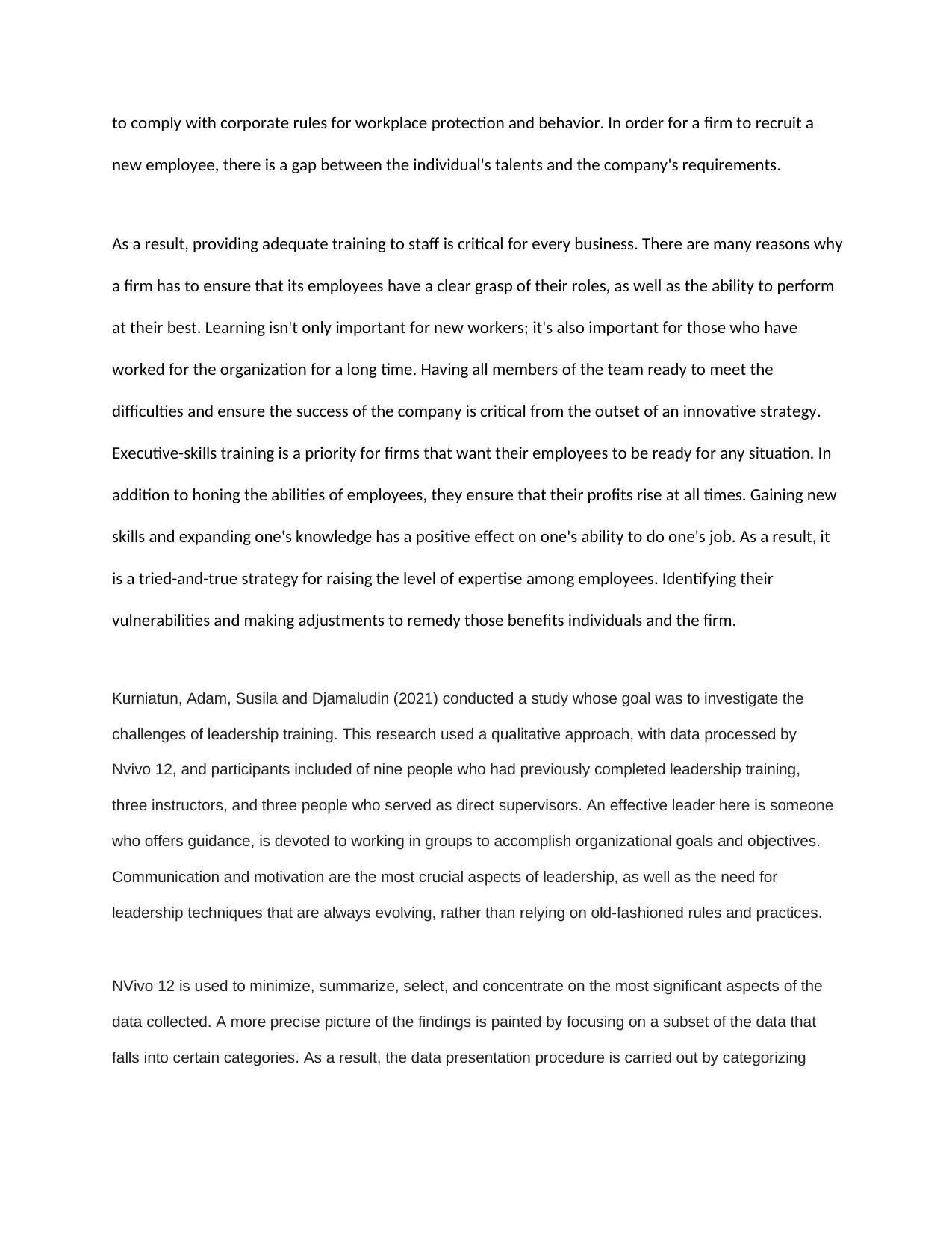
to comply with corporate rules for workplace protection and behavior. In order for a firm to recruit a
new employee, there is a gap between the individual's talents and the company's requirements.
As a result, providing adequate training to staff is critical for every business. There are many reasons why
a firm has to ensure that its employees have a clear grasp of their roles, as well as the ability to perform
at their best. Learning isn't only important for new workers; it's also important for those who have
worked for the organization for a long time. Having all members of the team ready to meet the
difficulties and ensure the success of the company is critical from the outset of an innovative strategy.
Executive-skills training is a priority for firms that want their employees to be ready for any situation. In
addition to honing the abilities of employees, they ensure that their profits rise at all times. Gaining new
skills and expanding one's knowledge has a positive effect on one's ability to do one's job. As a result, it
is a tried-and-true strategy for raising the level of expertise among employees. Identifying their
vulnerabilities and making adjustments to remedy those benefits individuals and the firm.
Kurniatun, Adam, Susila and Djamaludin (2021) conducted a study whose goal was to investigate the
challenges of leadership training. This research used a qualitative approach, with data processed by
Nvivo 12, and participants included of nine people who had previously completed leadership training,
three instructors, and three people who served as direct supervisors. An effective leader here is someone
who offers guidance, is devoted to working in groups to accomplish organizational goals and objectives.
Communication and motivation are the most crucial aspects of leadership, as well as the need for
leadership techniques that are always evolving, rather than relying on old-fashioned rules and practices.
NVivo 12 is used to minimize, summarize, select, and concentrate on the most significant aspects of the
data collected. A more precise picture of the findings is painted by focusing on a subset of the data that
falls into certain categories. As a result, the data presentation procedure is carried out by categorizing
new employee, there is a gap between the individual's talents and the company's requirements.
As a result, providing adequate training to staff is critical for every business. There are many reasons why
a firm has to ensure that its employees have a clear grasp of their roles, as well as the ability to perform
at their best. Learning isn't only important for new workers; it's also important for those who have
worked for the organization for a long time. Having all members of the team ready to meet the
difficulties and ensure the success of the company is critical from the outset of an innovative strategy.
Executive-skills training is a priority for firms that want their employees to be ready for any situation. In
addition to honing the abilities of employees, they ensure that their profits rise at all times. Gaining new
skills and expanding one's knowledge has a positive effect on one's ability to do one's job. As a result, it
is a tried-and-true strategy for raising the level of expertise among employees. Identifying their
vulnerabilities and making adjustments to remedy those benefits individuals and the firm.
Kurniatun, Adam, Susila and Djamaludin (2021) conducted a study whose goal was to investigate the
challenges of leadership training. This research used a qualitative approach, with data processed by
Nvivo 12, and participants included of nine people who had previously completed leadership training,
three instructors, and three people who served as direct supervisors. An effective leader here is someone
who offers guidance, is devoted to working in groups to accomplish organizational goals and objectives.
Communication and motivation are the most crucial aspects of leadership, as well as the need for
leadership techniques that are always evolving, rather than relying on old-fashioned rules and practices.
NVivo 12 is used to minimize, summarize, select, and concentrate on the most significant aspects of the
data collected. A more precise picture of the findings is painted by focusing on a subset of the data that
falls into certain categories. As a result, the data presentation procedure is carried out by categorizing
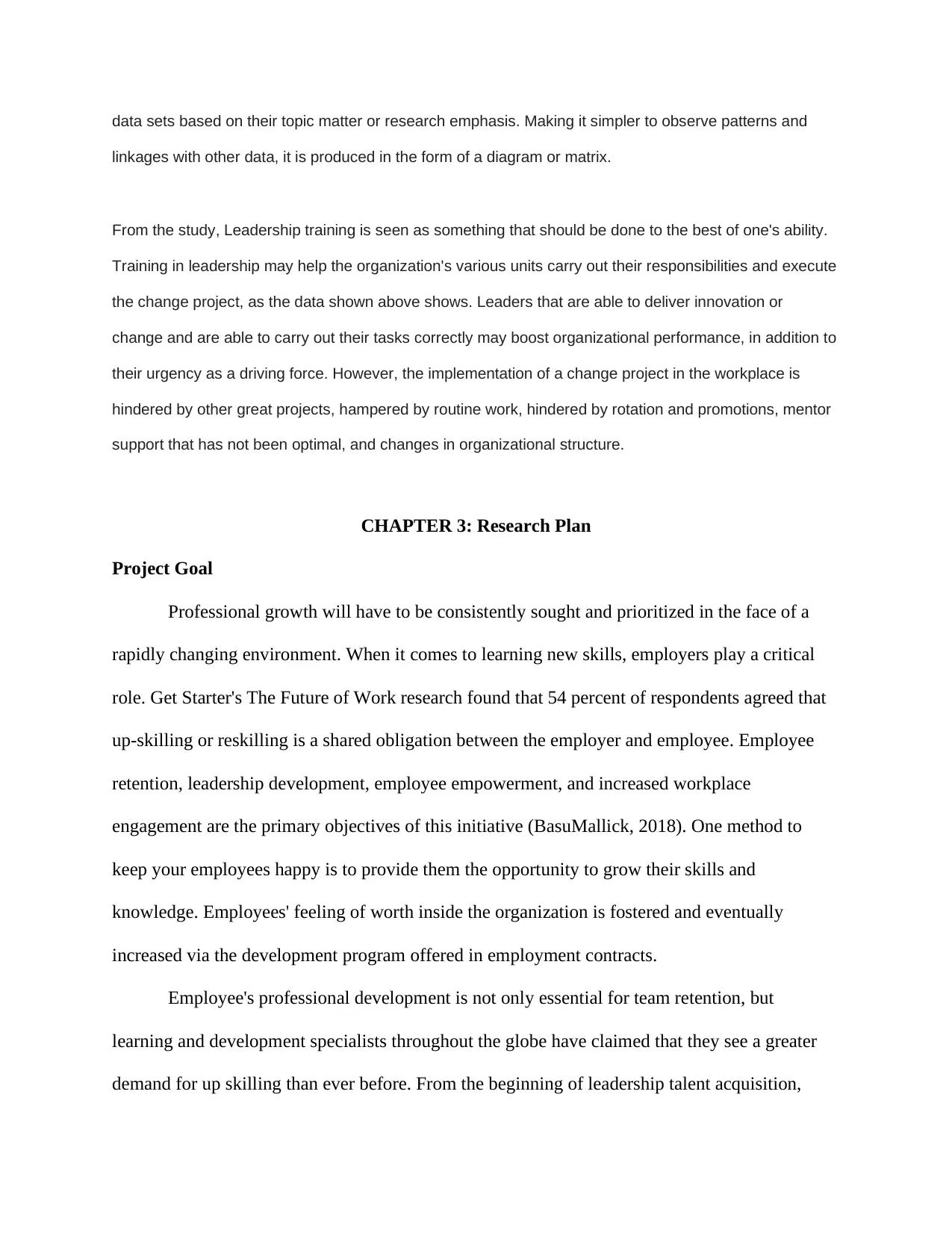
data sets based on their topic matter or research emphasis. Making it simpler to observe patterns and
linkages with other data, it is produced in the form of a diagram or matrix.
From the study, Leadership training is seen as something that should be done to the best of one's ability.
Training in leadership may help the organization's various units carry out their responsibilities and execute
the change project, as the data shown above shows. Leaders that are able to deliver innovation or
change and are able to carry out their tasks correctly may boost organizational performance, in addition to
their urgency as a driving force. However, the implementation of a change project in the workplace is
hindered by other great projects, hampered by routine work, hindered by rotation and promotions, mentor
support that has not been optimal, and changes in organizational structure.
CHAPTER 3: Research Plan
Project Goal
Professional growth will have to be consistently sought and prioritized in the face of a
rapidly changing environment. When it comes to learning new skills, employers play a critical
role. Get Starter's The Future of Work research found that 54 percent of respondents agreed that
up-skilling or reskilling is a shared obligation between the employer and employee. Employee
retention, leadership development, employee empowerment, and increased workplace
engagement are the primary objectives of this initiative (BasuMallick, 2018). One method to
keep your employees happy is to provide them the opportunity to grow their skills and
knowledge. Employees' feeling of worth inside the organization is fostered and eventually
increased via the development program offered in employment contracts.
Employee's professional development is not only essential for team retention, but
learning and development specialists throughout the globe have claimed that they see a greater
demand for up skilling than ever before. From the beginning of leadership talent acquisition,
linkages with other data, it is produced in the form of a diagram or matrix.
From the study, Leadership training is seen as something that should be done to the best of one's ability.
Training in leadership may help the organization's various units carry out their responsibilities and execute
the change project, as the data shown above shows. Leaders that are able to deliver innovation or
change and are able to carry out their tasks correctly may boost organizational performance, in addition to
their urgency as a driving force. However, the implementation of a change project in the workplace is
hindered by other great projects, hampered by routine work, hindered by rotation and promotions, mentor
support that has not been optimal, and changes in organizational structure.
CHAPTER 3: Research Plan
Project Goal
Professional growth will have to be consistently sought and prioritized in the face of a
rapidly changing environment. When it comes to learning new skills, employers play a critical
role. Get Starter's The Future of Work research found that 54 percent of respondents agreed that
up-skilling or reskilling is a shared obligation between the employer and employee. Employee
retention, leadership development, employee empowerment, and increased workplace
engagement are the primary objectives of this initiative (BasuMallick, 2018). One method to
keep your employees happy is to provide them the opportunity to grow their skills and
knowledge. Employees' feeling of worth inside the organization is fostered and eventually
increased via the development program offered in employment contracts.
Employee's professional development is not only essential for team retention, but
learning and development specialists throughout the globe have claimed that they see a greater
demand for up skilling than ever before. From the beginning of leadership talent acquisition,
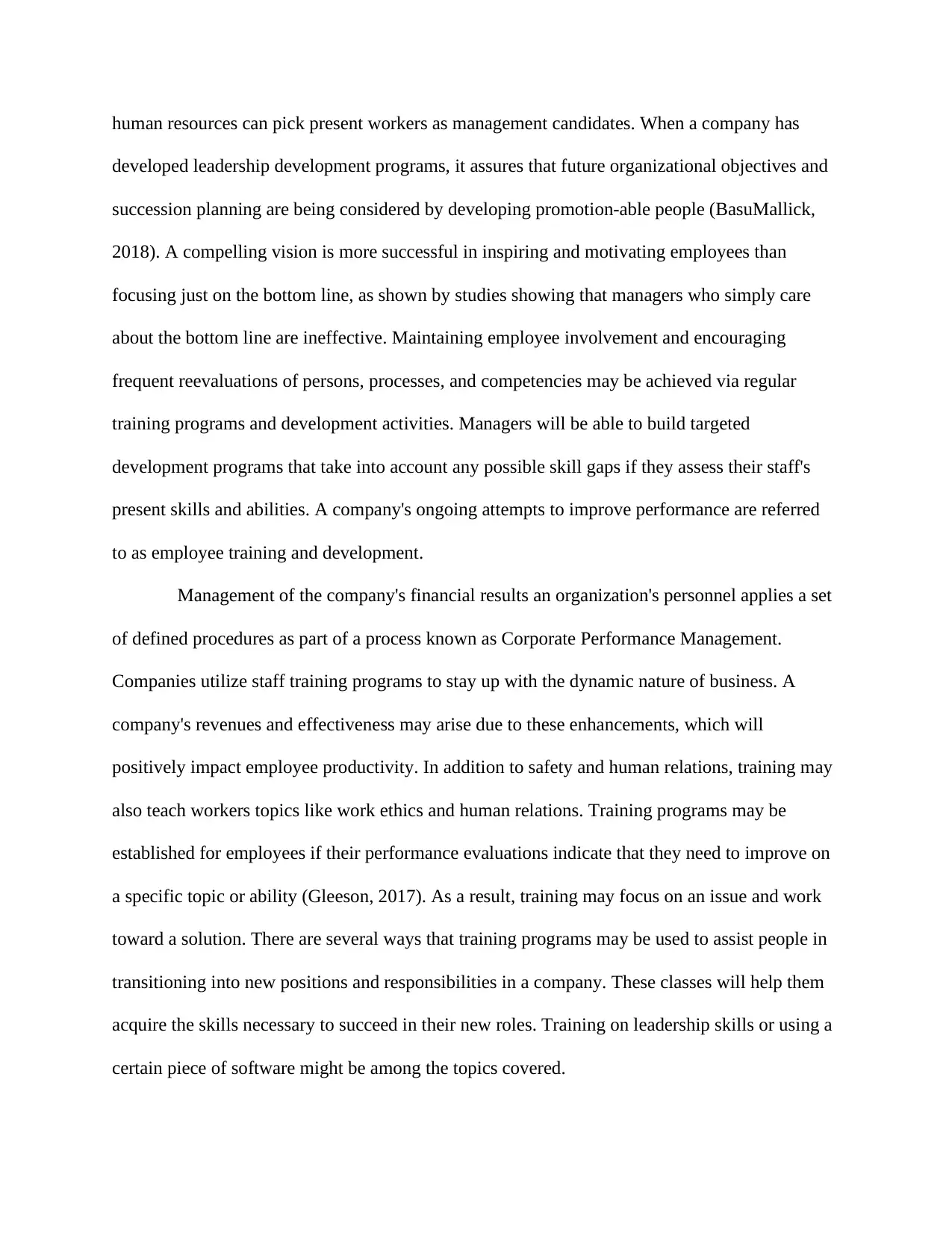
human resources can pick present workers as management candidates. When a company has
developed leadership development programs, it assures that future organizational objectives and
succession planning are being considered by developing promotion-able people (BasuMallick,
2018). A compelling vision is more successful in inspiring and motivating employees than
focusing just on the bottom line, as shown by studies showing that managers who simply care
about the bottom line are ineffective. Maintaining employee involvement and encouraging
frequent reevaluations of persons, processes, and competencies may be achieved via regular
training programs and development activities. Managers will be able to build targeted
development programs that take into account any possible skill gaps if they assess their staff's
present skills and abilities. A company's ongoing attempts to improve performance are referred
to as employee training and development.
Management of the company's financial results an organization's personnel applies a set
of defined procedures as part of a process known as Corporate Performance Management.
Companies utilize staff training programs to stay up with the dynamic nature of business. A
company's revenues and effectiveness may arise due to these enhancements, which will
positively impact employee productivity. In addition to safety and human relations, training may
also teach workers topics like work ethics and human relations. Training programs may be
established for employees if their performance evaluations indicate that they need to improve on
a specific topic or ability (Gleeson, 2017). As a result, training may focus on an issue and work
toward a solution. There are several ways that training programs may be used to assist people in
transitioning into new positions and responsibilities in a company. These classes will help them
acquire the skills necessary to succeed in their new roles. Training on leadership skills or using a
certain piece of software might be among the topics covered.
developed leadership development programs, it assures that future organizational objectives and
succession planning are being considered by developing promotion-able people (BasuMallick,
2018). A compelling vision is more successful in inspiring and motivating employees than
focusing just on the bottom line, as shown by studies showing that managers who simply care
about the bottom line are ineffective. Maintaining employee involvement and encouraging
frequent reevaluations of persons, processes, and competencies may be achieved via regular
training programs and development activities. Managers will be able to build targeted
development programs that take into account any possible skill gaps if they assess their staff's
present skills and abilities. A company's ongoing attempts to improve performance are referred
to as employee training and development.
Management of the company's financial results an organization's personnel applies a set
of defined procedures as part of a process known as Corporate Performance Management.
Companies utilize staff training programs to stay up with the dynamic nature of business. A
company's revenues and effectiveness may arise due to these enhancements, which will
positively impact employee productivity. In addition to safety and human relations, training may
also teach workers topics like work ethics and human relations. Training programs may be
established for employees if their performance evaluations indicate that they need to improve on
a specific topic or ability (Gleeson, 2017). As a result, training may focus on an issue and work
toward a solution. There are several ways that training programs may be used to assist people in
transitioning into new positions and responsibilities in a company. These classes will help them
acquire the skills necessary to succeed in their new roles. Training on leadership skills or using a
certain piece of software might be among the topics covered.
Secure Best Marks with AI Grader
Need help grading? Try our AI Grader for instant feedback on your assignments.
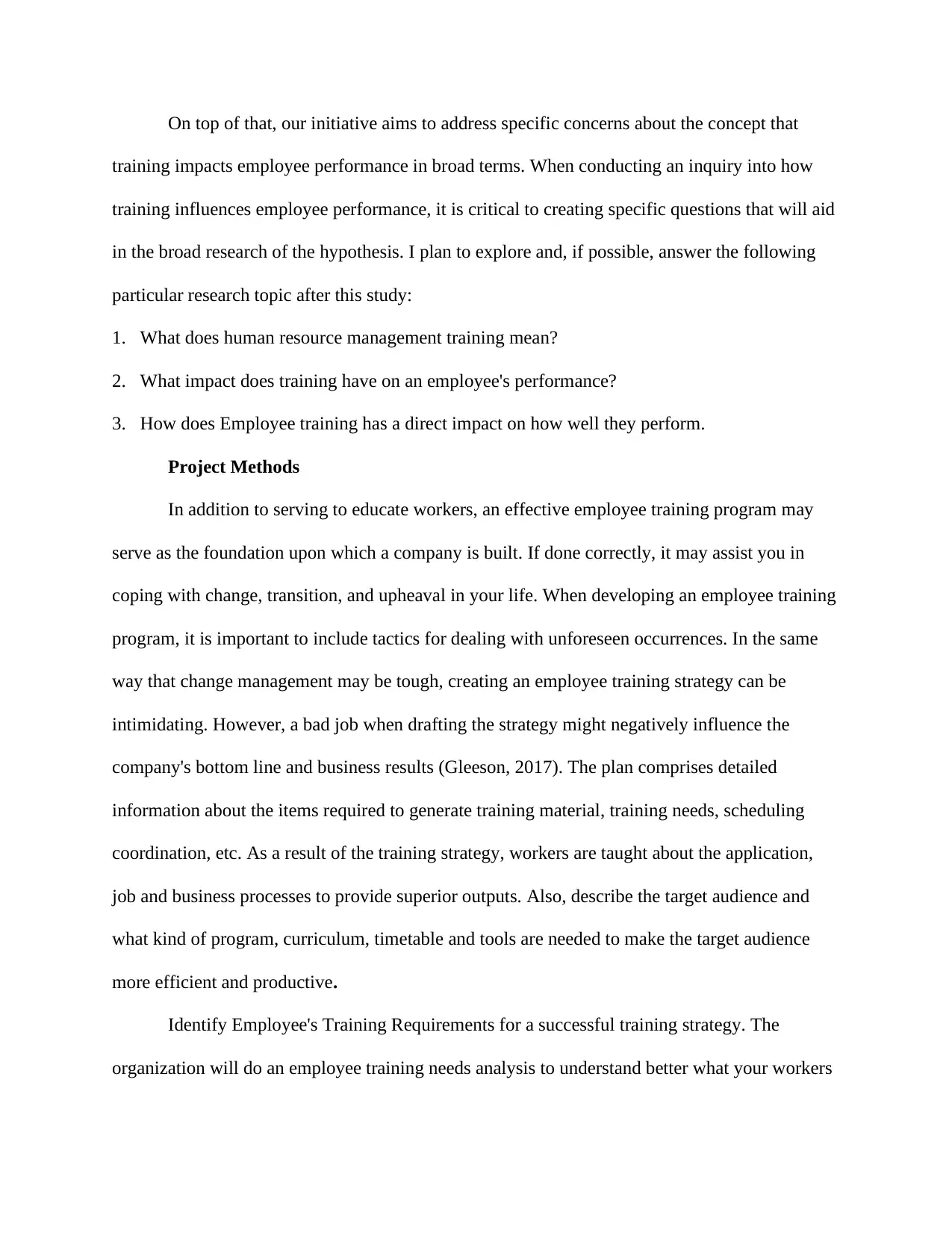
On top of that, our initiative aims to address specific concerns about the concept that
training impacts employee performance in broad terms. When conducting an inquiry into how
training influences employee performance, it is critical to creating specific questions that will aid
in the broad research of the hypothesis. I plan to explore and, if possible, answer the following
particular research topic after this study:
1. What does human resource management training mean?
2. What impact does training have on an employee's performance?
3. How does Employee training has a direct impact on how well they perform.
Project Methods
In addition to serving to educate workers, an effective employee training program may
serve as the foundation upon which a company is built. If done correctly, it may assist you in
coping with change, transition, and upheaval in your life. When developing an employee training
program, it is important to include tactics for dealing with unforeseen occurrences. In the same
way that change management may be tough, creating an employee training strategy can be
intimidating. However, a bad job when drafting the strategy might negatively influence the
company's bottom line and business results (Gleeson, 2017). The plan comprises detailed
information about the items required to generate training material, training needs, scheduling
coordination, etc. As a result of the training strategy, workers are taught about the application,
job and business processes to provide superior outputs. Also, describe the target audience and
what kind of program, curriculum, timetable and tools are needed to make the target audience
more efficient and productive.
Identify Employee's Training Requirements for a successful training strategy. The
organization will do an employee training needs analysis to understand better what your workers
training impacts employee performance in broad terms. When conducting an inquiry into how
training influences employee performance, it is critical to creating specific questions that will aid
in the broad research of the hypothesis. I plan to explore and, if possible, answer the following
particular research topic after this study:
1. What does human resource management training mean?
2. What impact does training have on an employee's performance?
3. How does Employee training has a direct impact on how well they perform.
Project Methods
In addition to serving to educate workers, an effective employee training program may
serve as the foundation upon which a company is built. If done correctly, it may assist you in
coping with change, transition, and upheaval in your life. When developing an employee training
program, it is important to include tactics for dealing with unforeseen occurrences. In the same
way that change management may be tough, creating an employee training strategy can be
intimidating. However, a bad job when drafting the strategy might negatively influence the
company's bottom line and business results (Gleeson, 2017). The plan comprises detailed
information about the items required to generate training material, training needs, scheduling
coordination, etc. As a result of the training strategy, workers are taught about the application,
job and business processes to provide superior outputs. Also, describe the target audience and
what kind of program, curriculum, timetable and tools are needed to make the target audience
more efficient and productive.
Identify Employee's Training Requirements for a successful training strategy. The
organization will do an employee training needs analysis to understand better what your workers
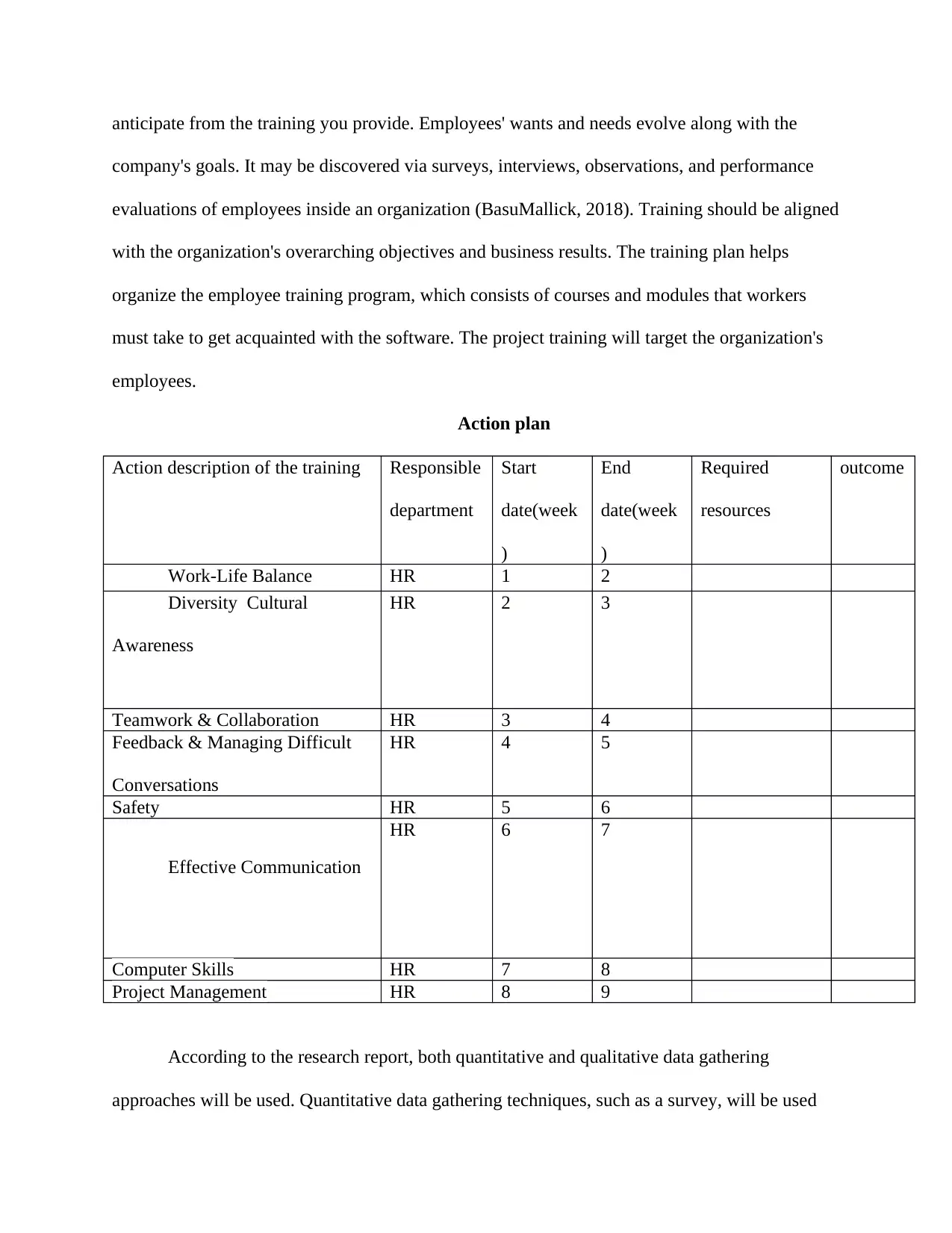
anticipate from the training you provide. Employees' wants and needs evolve along with the
company's goals. It may be discovered via surveys, interviews, observations, and performance
evaluations of employees inside an organization (BasuMallick, 2018). Training should be aligned
with the organization's overarching objectives and business results. The training plan helps
organize the employee training program, which consists of courses and modules that workers
must take to get acquainted with the software. The project training will target the organization's
employees.
Action plan
Action description of the training Responsible
department
Start
date(week
)
End
date(week
)
Required
resources
outcome
Work-Life Balance HR 1 2
Diversity Cultural
Awareness
HR 2 3
Teamwork & Collaboration HR 3 4
Feedback & Managing Difficult
Conversations
HR 4 5
Safety HR 5 6
Effective Communication
HR 6 7
Computer Skills HR 7 8
Project Management HR 8 9
According to the research report, both quantitative and qualitative data gathering
approaches will be used. Quantitative data gathering techniques, such as a survey, will be used
company's goals. It may be discovered via surveys, interviews, observations, and performance
evaluations of employees inside an organization (BasuMallick, 2018). Training should be aligned
with the organization's overarching objectives and business results. The training plan helps
organize the employee training program, which consists of courses and modules that workers
must take to get acquainted with the software. The project training will target the organization's
employees.
Action plan
Action description of the training Responsible
department
Start
date(week
)
End
date(week
)
Required
resources
outcome
Work-Life Balance HR 1 2
Diversity Cultural
Awareness
HR 2 3
Teamwork & Collaboration HR 3 4
Feedback & Managing Difficult
Conversations
HR 4 5
Safety HR 5 6
Effective Communication
HR 6 7
Computer Skills HR 7 8
Project Management HR 8 9
According to the research report, both quantitative and qualitative data gathering
approaches will be used. Quantitative data gathering techniques, such as a survey, will be used

extensively throughout the study to gather information, categorize it, and identify trends before
generalizations can be drawn. As a result, researchers will use the qualitative technique to
analyze the acquired data and contextualize it for better understanding. Thus, both qualitative and
quantitative methodologies will be used to ensure a full examination of the data gathered
(Knights, 2017). That's why we chose to combine both ways since, in this context, they showed
to be the most successful in aiding the assessment of the contents. Methods used in this study
will help demonstrate the link between the results, discussion, and discoveries of this whole work
thus far. Because there are so many ways to do research, it's impossible to say for sure that if the
researcher utilizes different mythology, the same findings won't be obtained with even greater
precision. Because of time, resources, and cost-effectiveness, the design and technique selected
will be excellent in this context and most suited for addressing the research objectives (Gleeson,
2017). Therefore, the design and technique adopted in this study will help produce a broader
position of the ideas and ensure the validity and reliability of this research based on the
replication of previously explored information.
Project Measurements
The effectiveness of the project's execution is evaluated via the use of project process
measurements. There are two types of metrics that may be used to quantify a project's output: the
cost of the project and the time it takes to complete. The project's scope, timetable, budget,
personnel satisfaction, client satisfaction, and quality will be assessed. 'There are two types of
metrics that may be used to quantify a project's output: the cost of the project and the time it
takes to complete. The project's scope, timetable, budget, personnel satisfaction, client
satisfaction, and quality will be assessed (Gleeson, 2017). The scope is the goal of a project and
what it takes to achieve it. The project's success can only be measured if you know whether it
generalizations can be drawn. As a result, researchers will use the qualitative technique to
analyze the acquired data and contextualize it for better understanding. Thus, both qualitative and
quantitative methodologies will be used to ensure a full examination of the data gathered
(Knights, 2017). That's why we chose to combine both ways since, in this context, they showed
to be the most successful in aiding the assessment of the contents. Methods used in this study
will help demonstrate the link between the results, discussion, and discoveries of this whole work
thus far. Because there are so many ways to do research, it's impossible to say for sure that if the
researcher utilizes different mythology, the same findings won't be obtained with even greater
precision. Because of time, resources, and cost-effectiveness, the design and technique selected
will be excellent in this context and most suited for addressing the research objectives (Gleeson,
2017). Therefore, the design and technique adopted in this study will help produce a broader
position of the ideas and ensure the validity and reliability of this research based on the
replication of previously explored information.
Project Measurements
The effectiveness of the project's execution is evaluated via the use of project process
measurements. There are two types of metrics that may be used to quantify a project's output: the
cost of the project and the time it takes to complete. The project's scope, timetable, budget,
personnel satisfaction, client satisfaction, and quality will be assessed. 'There are two types of
metrics that may be used to quantify a project's output: the cost of the project and the time it
takes to complete. The project's scope, timetable, budget, personnel satisfaction, client
satisfaction, and quality will be assessed (Gleeson, 2017). The scope is the goal of a project and
what it takes to achieve it. The project's success can only be measured if you know whether it
Paraphrase This Document
Need a fresh take? Get an instant paraphrase of this document with our AI Paraphraser

fulfilled its goals within the allotted time limit. The timetable may be measured and understood
with relative ease. Is it true that you were able to meet your goals? Did you meet your deadline
for delivering your project? Does anybody know whether it's on time or how much behind
schedule it was? Are they capable of completing the job on time and within the budget? Was it
too high or too low? And if so, by what amount? It should come as no surprise that completing
your project on time and budget is one of the most important measures of your success (Knights,
2017). When analyzing project performance, it's easy to underestimate the importance of team
contentment. Then, I argue that team satisfaction should be at the top of the organization's
criterion for success. Because they've been there, they'll be there when you go on your next
project journey as well. They also have insights that even the most powerful people in the
organization may lack. Your customers' opinions are just as important to your company as your
employees. How satisfied are they with the outcome? Did they get what they wanted?
You must establish a method for monitoring customer satisfaction throughout all project
phases from conception to completion. On the quality, Rather than just completing the task at
hand, the goal here is to surpass all of your clients' expectations. It's critical to keep an eye on
quality and make corrections as needed. It is common for quality assurance to continue even
after a project has been completed. In the end, companies want to know whether the project was
successful and how well it was executed (Gleeson, 2017). Is it easy to execute the findings? Are
you and your coworkers happy with the final product? Project success isn't always black or
white; shades of gray are more difficult to assess but are well worth investigating. The more
projects you complete and iron out the kinks of, the more successful they will be. After
completing a project, it's a good idea to evaluate its success. A chance to learn and analyze the
project's genuine effectiveness will be provided for future endeavors.
with relative ease. Is it true that you were able to meet your goals? Did you meet your deadline
for delivering your project? Does anybody know whether it's on time or how much behind
schedule it was? Are they capable of completing the job on time and within the budget? Was it
too high or too low? And if so, by what amount? It should come as no surprise that completing
your project on time and budget is one of the most important measures of your success (Knights,
2017). When analyzing project performance, it's easy to underestimate the importance of team
contentment. Then, I argue that team satisfaction should be at the top of the organization's
criterion for success. Because they've been there, they'll be there when you go on your next
project journey as well. They also have insights that even the most powerful people in the
organization may lack. Your customers' opinions are just as important to your company as your
employees. How satisfied are they with the outcome? Did they get what they wanted?
You must establish a method for monitoring customer satisfaction throughout all project
phases from conception to completion. On the quality, Rather than just completing the task at
hand, the goal here is to surpass all of your clients' expectations. It's critical to keep an eye on
quality and make corrections as needed. It is common for quality assurance to continue even
after a project has been completed. In the end, companies want to know whether the project was
successful and how well it was executed (Gleeson, 2017). Is it easy to execute the findings? Are
you and your coworkers happy with the final product? Project success isn't always black or
white; shades of gray are more difficult to assess but are well worth investigating. The more
projects you complete and iron out the kinks of, the more successful they will be. After
completing a project, it's a good idea to evaluate its success. A chance to learn and analyze the
project's genuine effectiveness will be provided for future endeavors.
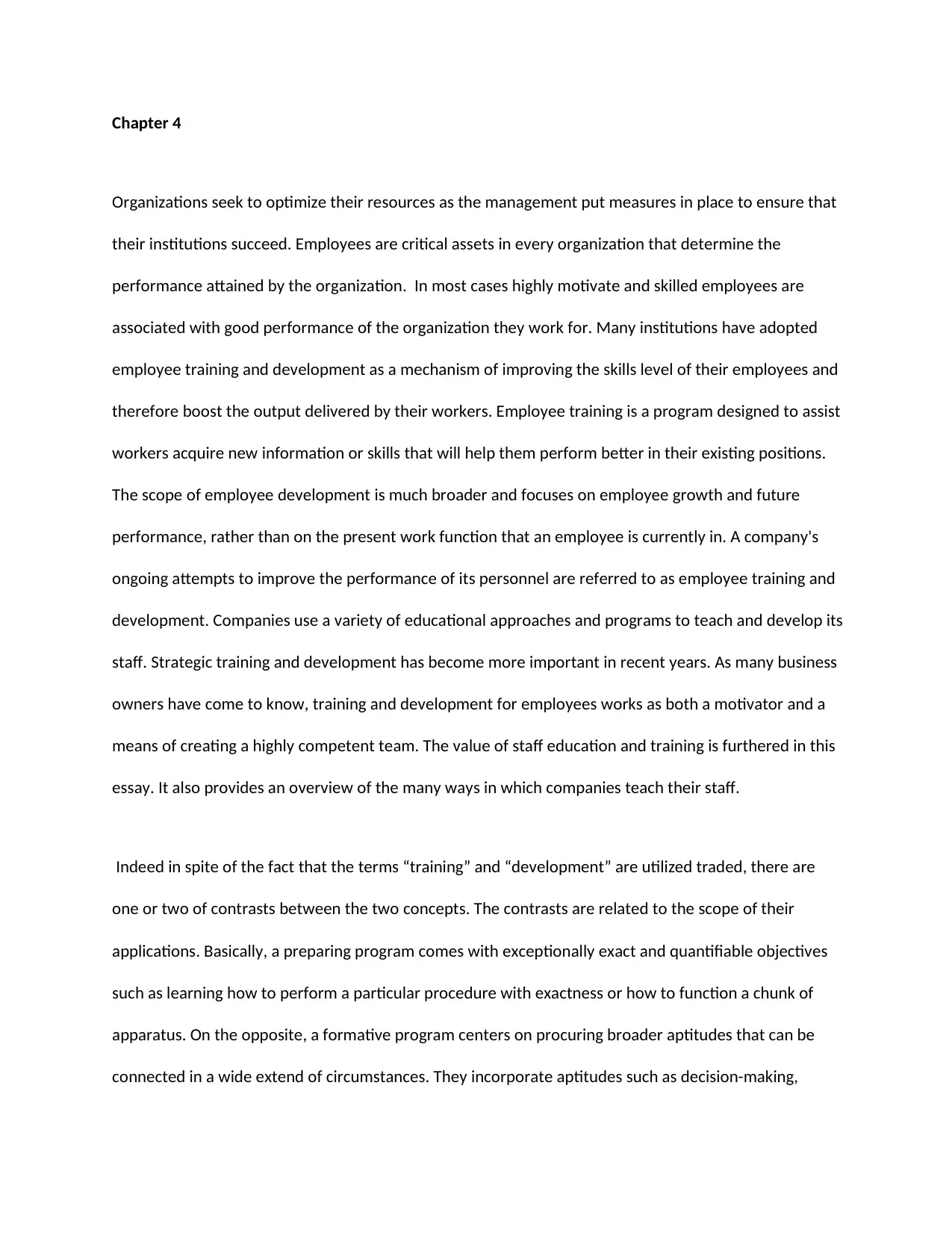
Chapter 4
Organizations seek to optimize their resources as the management put measures in place to ensure that
their institutions succeed. Employees are critical assets in every organization that determine the
performance attained by the organization. In most cases highly motivate and skilled employees are
associated with good performance of the organization they work for. Many institutions have adopted
employee training and development as a mechanism of improving the skills level of their employees and
therefore boost the output delivered by their workers. Employee training is a program designed to assist
workers acquire new information or skills that will help them perform better in their existing positions.
The scope of employee development is much broader and focuses on employee growth and future
performance, rather than on the present work function that an employee is currently in. A company's
ongoing attempts to improve the performance of its personnel are referred to as employee training and
development. Companies use a variety of educational approaches and programs to teach and develop its
staff. Strategic training and development has become more important in recent years. As many business
owners have come to know, training and development for employees works as both a motivator and a
means of creating a highly competent team. The value of staff education and training is furthered in this
essay. It also provides an overview of the many ways in which companies teach their staff.
Indeed in spite of the fact that the terms “training” and “development” are utilized traded, there are
one or two of contrasts between the two concepts. The contrasts are related to the scope of their
applications. Basically, a preparing program comes with exceptionally exact and quantifiable objectives
such as learning how to perform a particular procedure with exactness or how to function a chunk of
apparatus. On the opposite, a formative program centers on procuring broader aptitudes that can be
connected in a wide extend of circumstances. They incorporate aptitudes such as decision-making,
Organizations seek to optimize their resources as the management put measures in place to ensure that
their institutions succeed. Employees are critical assets in every organization that determine the
performance attained by the organization. In most cases highly motivate and skilled employees are
associated with good performance of the organization they work for. Many institutions have adopted
employee training and development as a mechanism of improving the skills level of their employees and
therefore boost the output delivered by their workers. Employee training is a program designed to assist
workers acquire new information or skills that will help them perform better in their existing positions.
The scope of employee development is much broader and focuses on employee growth and future
performance, rather than on the present work function that an employee is currently in. A company's
ongoing attempts to improve the performance of its personnel are referred to as employee training and
development. Companies use a variety of educational approaches and programs to teach and develop its
staff. Strategic training and development has become more important in recent years. As many business
owners have come to know, training and development for employees works as both a motivator and a
means of creating a highly competent team. The value of staff education and training is furthered in this
essay. It also provides an overview of the many ways in which companies teach their staff.
Indeed in spite of the fact that the terms “training” and “development” are utilized traded, there are
one or two of contrasts between the two concepts. The contrasts are related to the scope of their
applications. Basically, a preparing program comes with exceptionally exact and quantifiable objectives
such as learning how to perform a particular procedure with exactness or how to function a chunk of
apparatus. On the opposite, a formative program centers on procuring broader aptitudes that can be
connected in a wide extend of circumstances. They incorporate aptitudes such as decision-making,
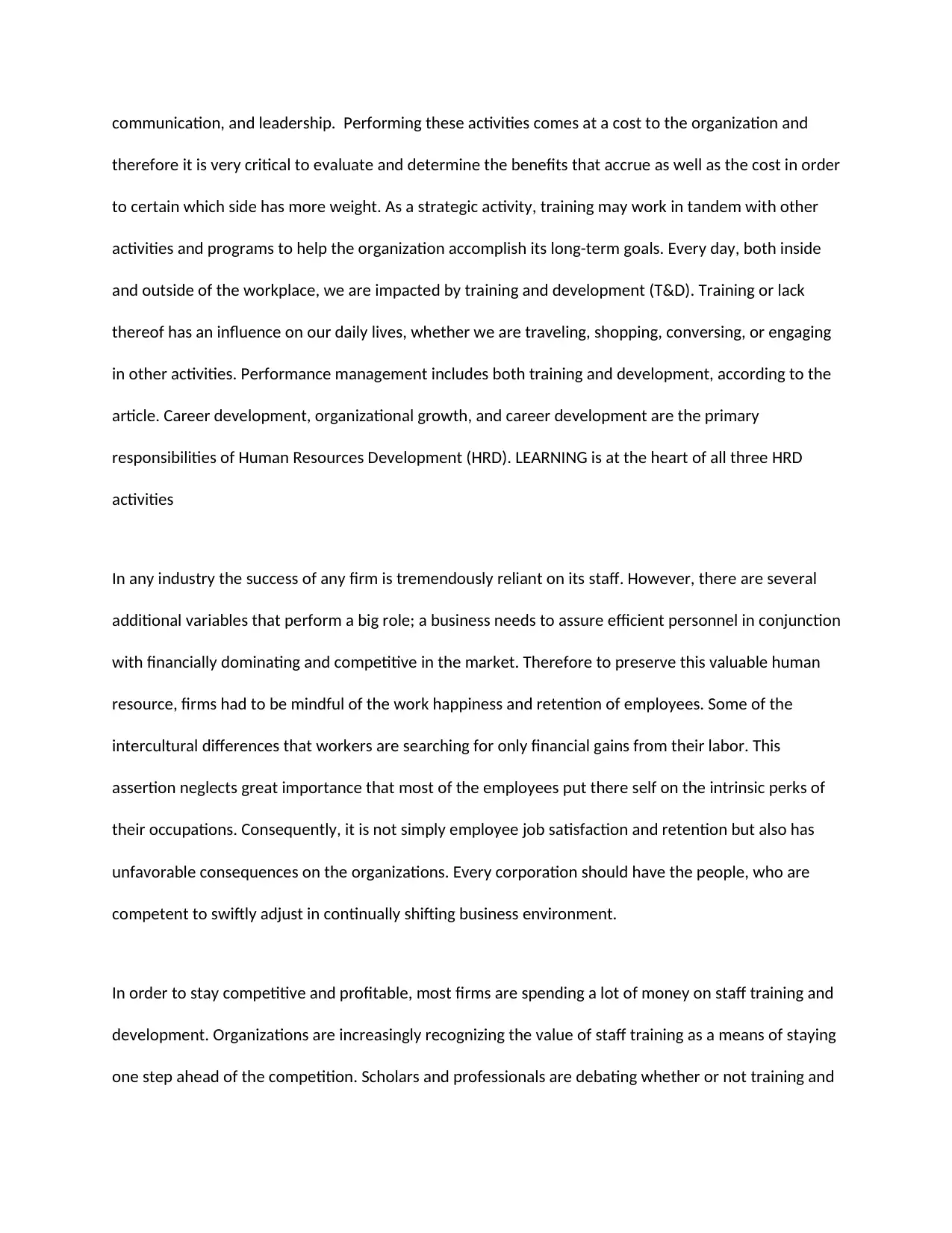
communication, and leadership. Performing these activities comes at a cost to the organization and
therefore it is very critical to evaluate and determine the benefits that accrue as well as the cost in order
to certain which side has more weight. As a strategic activity, training may work in tandem with other
activities and programs to help the organization accomplish its long-term goals. Every day, both inside
and outside of the workplace, we are impacted by training and development (T&D). Training or lack
thereof has an influence on our daily lives, whether we are traveling, shopping, conversing, or engaging
in other activities. Performance management includes both training and development, according to the
article. Career development, organizational growth, and career development are the primary
responsibilities of Human Resources Development (HRD). LEARNING is at the heart of all three HRD
activities
In any industry the success of any firm is tremendously reliant on its staff. However, there are several
additional variables that perform a big role; a business needs to assure efficient personnel in conjunction
with financially dominating and competitive in the market. Therefore to preserve this valuable human
resource, firms had to be mindful of the work happiness and retention of employees. Some of the
intercultural differences that workers are searching for only financial gains from their labor. This
assertion neglects great importance that most of the employees put there self on the intrinsic perks of
their occupations. Consequently, it is not simply employee job satisfaction and retention but also has
unfavorable consequences on the organizations. Every corporation should have the people, who are
competent to swiftly adjust in continually shifting business environment.
In order to stay competitive and profitable, most firms are spending a lot of money on staff training and
development. Organizations are increasingly recognizing the value of staff training as a means of staying
one step ahead of the competition. Scholars and professionals are debating whether or not training and
therefore it is very critical to evaluate and determine the benefits that accrue as well as the cost in order
to certain which side has more weight. As a strategic activity, training may work in tandem with other
activities and programs to help the organization accomplish its long-term goals. Every day, both inside
and outside of the workplace, we are impacted by training and development (T&D). Training or lack
thereof has an influence on our daily lives, whether we are traveling, shopping, conversing, or engaging
in other activities. Performance management includes both training and development, according to the
article. Career development, organizational growth, and career development are the primary
responsibilities of Human Resources Development (HRD). LEARNING is at the heart of all three HRD
activities
In any industry the success of any firm is tremendously reliant on its staff. However, there are several
additional variables that perform a big role; a business needs to assure efficient personnel in conjunction
with financially dominating and competitive in the market. Therefore to preserve this valuable human
resource, firms had to be mindful of the work happiness and retention of employees. Some of the
intercultural differences that workers are searching for only financial gains from their labor. This
assertion neglects great importance that most of the employees put there self on the intrinsic perks of
their occupations. Consequently, it is not simply employee job satisfaction and retention but also has
unfavorable consequences on the organizations. Every corporation should have the people, who are
competent to swiftly adjust in continually shifting business environment.
In order to stay competitive and profitable, most firms are spending a lot of money on staff training and
development. Organizations are increasingly recognizing the value of staff training as a means of staying
one step ahead of the competition. Scholars and professionals are debating whether or not training and
Secure Best Marks with AI Grader
Need help grading? Try our AI Grader for instant feedback on your assignments.
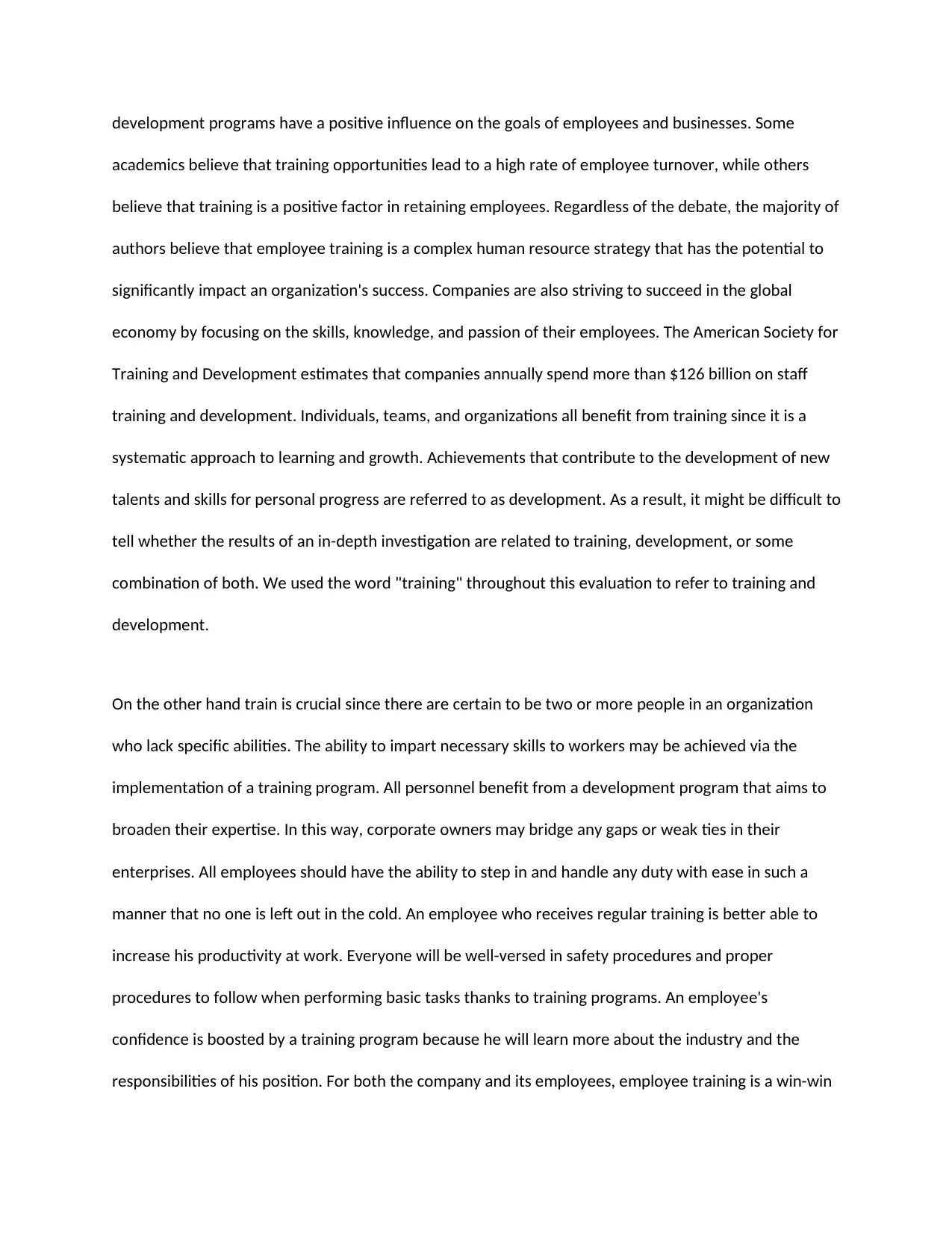
development programs have a positive influence on the goals of employees and businesses. Some
academics believe that training opportunities lead to a high rate of employee turnover, while others
believe that training is a positive factor in retaining employees. Regardless of the debate, the majority of
authors believe that employee training is a complex human resource strategy that has the potential to
significantly impact an organization's success. Companies are also striving to succeed in the global
economy by focusing on the skills, knowledge, and passion of their employees. The American Society for
Training and Development estimates that companies annually spend more than $126 billion on staff
training and development. Individuals, teams, and organizations all benefit from training since it is a
systematic approach to learning and growth. Achievements that contribute to the development of new
talents and skills for personal progress are referred to as development. As a result, it might be difficult to
tell whether the results of an in-depth investigation are related to training, development, or some
combination of both. We used the word "training" throughout this evaluation to refer to training and
development.
On the other hand train is crucial since there are certain to be two or more people in an organization
who lack specific abilities. The ability to impart necessary skills to workers may be achieved via the
implementation of a training program. All personnel benefit from a development program that aims to
broaden their expertise. In this way, corporate owners may bridge any gaps or weak ties in their
enterprises. All employees should have the ability to step in and handle any duty with ease in such a
manner that no one is left out in the cold. An employee who receives regular training is better able to
increase his productivity at work. Everyone will be well-versed in safety procedures and proper
procedures to follow when performing basic tasks thanks to training programs. An employee's
confidence is boosted by a training program because he will learn more about the industry and the
responsibilities of his position. For both the company and its employees, employee training is a win-win
academics believe that training opportunities lead to a high rate of employee turnover, while others
believe that training is a positive factor in retaining employees. Regardless of the debate, the majority of
authors believe that employee training is a complex human resource strategy that has the potential to
significantly impact an organization's success. Companies are also striving to succeed in the global
economy by focusing on the skills, knowledge, and passion of their employees. The American Society for
Training and Development estimates that companies annually spend more than $126 billion on staff
training and development. Individuals, teams, and organizations all benefit from training since it is a
systematic approach to learning and growth. Achievements that contribute to the development of new
talents and skills for personal progress are referred to as development. As a result, it might be difficult to
tell whether the results of an in-depth investigation are related to training, development, or some
combination of both. We used the word "training" throughout this evaluation to refer to training and
development.
On the other hand train is crucial since there are certain to be two or more people in an organization
who lack specific abilities. The ability to impart necessary skills to workers may be achieved via the
implementation of a training program. All personnel benefit from a development program that aims to
broaden their expertise. In this way, corporate owners may bridge any gaps or weak ties in their
enterprises. All employees should have the ability to step in and handle any duty with ease in such a
manner that no one is left out in the cold. An employee who receives regular training is better able to
increase his productivity at work. Everyone will be well-versed in safety procedures and proper
procedures to follow when performing basic tasks thanks to training programs. An employee's
confidence is boosted by a training program because he will learn more about the industry and the
responsibilities of his position. For both the company and its employees, employee training is a win-win
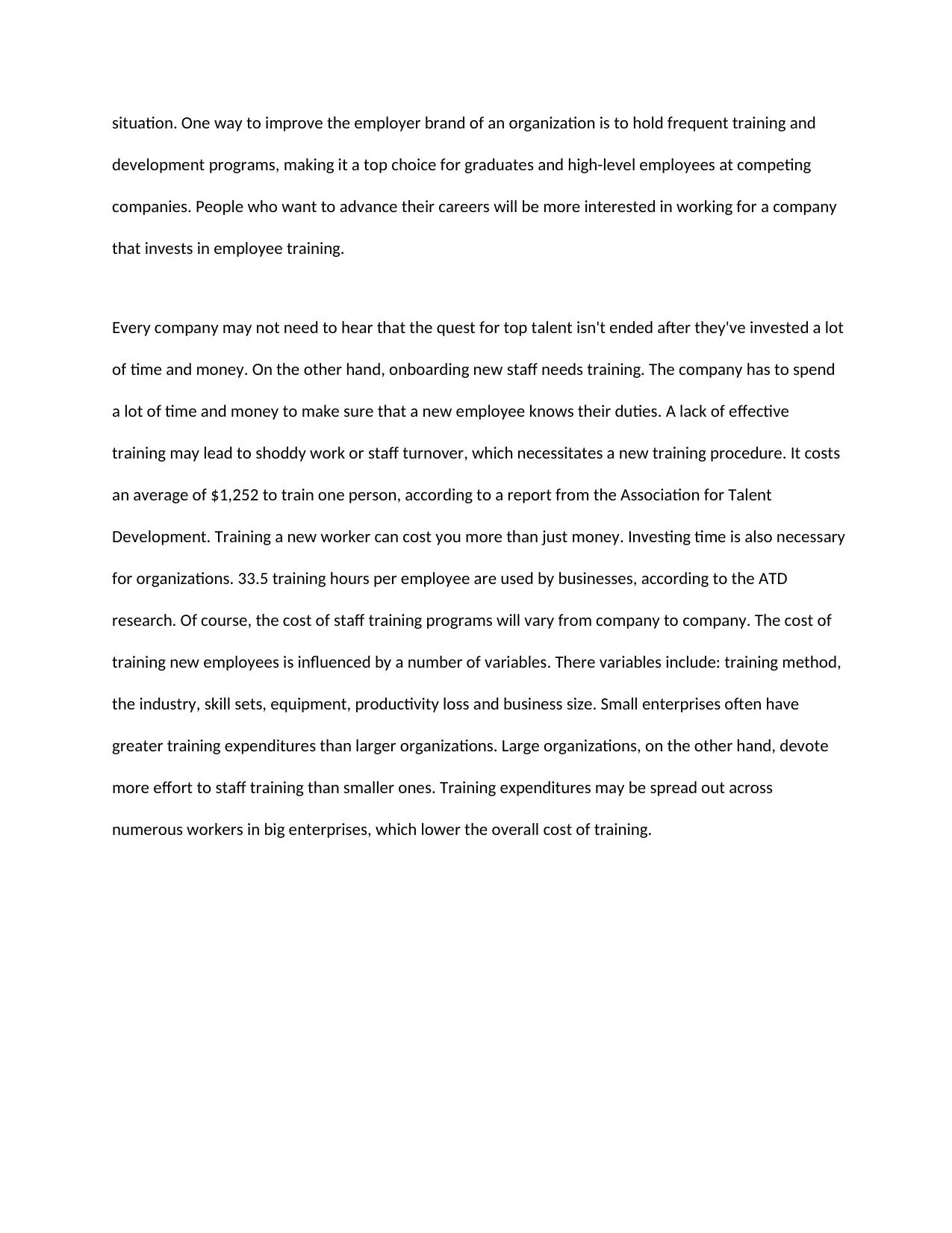
situation. One way to improve the employer brand of an organization is to hold frequent training and
development programs, making it a top choice for graduates and high-level employees at competing
companies. People who want to advance their careers will be more interested in working for a company
that invests in employee training.
Every company may not need to hear that the quest for top talent isn't ended after they've invested a lot
of time and money. On the other hand, onboarding new staff needs training. The company has to spend
a lot of time and money to make sure that a new employee knows their duties. A lack of effective
training may lead to shoddy work or staff turnover, which necessitates a new training procedure. It costs
an average of $1,252 to train one person, according to a report from the Association for Talent
Development. Training a new worker can cost you more than just money. Investing time is also necessary
for organizations. 33.5 training hours per employee are used by businesses, according to the ATD
research. Of course, the cost of staff training programs will vary from company to company. The cost of
training new employees is influenced by a number of variables. There variables include: training method,
the industry, skill sets, equipment, productivity loss and business size. Small enterprises often have
greater training expenditures than larger organizations. Large organizations, on the other hand, devote
more effort to staff training than smaller ones. Training expenditures may be spread out across
numerous workers in big enterprises, which lower the overall cost of training.
development programs, making it a top choice for graduates and high-level employees at competing
companies. People who want to advance their careers will be more interested in working for a company
that invests in employee training.
Every company may not need to hear that the quest for top talent isn't ended after they've invested a lot
of time and money. On the other hand, onboarding new staff needs training. The company has to spend
a lot of time and money to make sure that a new employee knows their duties. A lack of effective
training may lead to shoddy work or staff turnover, which necessitates a new training procedure. It costs
an average of $1,252 to train one person, according to a report from the Association for Talent
Development. Training a new worker can cost you more than just money. Investing time is also necessary
for organizations. 33.5 training hours per employee are used by businesses, according to the ATD
research. Of course, the cost of staff training programs will vary from company to company. The cost of
training new employees is influenced by a number of variables. There variables include: training method,
the industry, skill sets, equipment, productivity loss and business size. Small enterprises often have
greater training expenditures than larger organizations. Large organizations, on the other hand, devote
more effort to staff training than smaller ones. Training expenditures may be spread out across
numerous workers in big enterprises, which lower the overall cost of training.
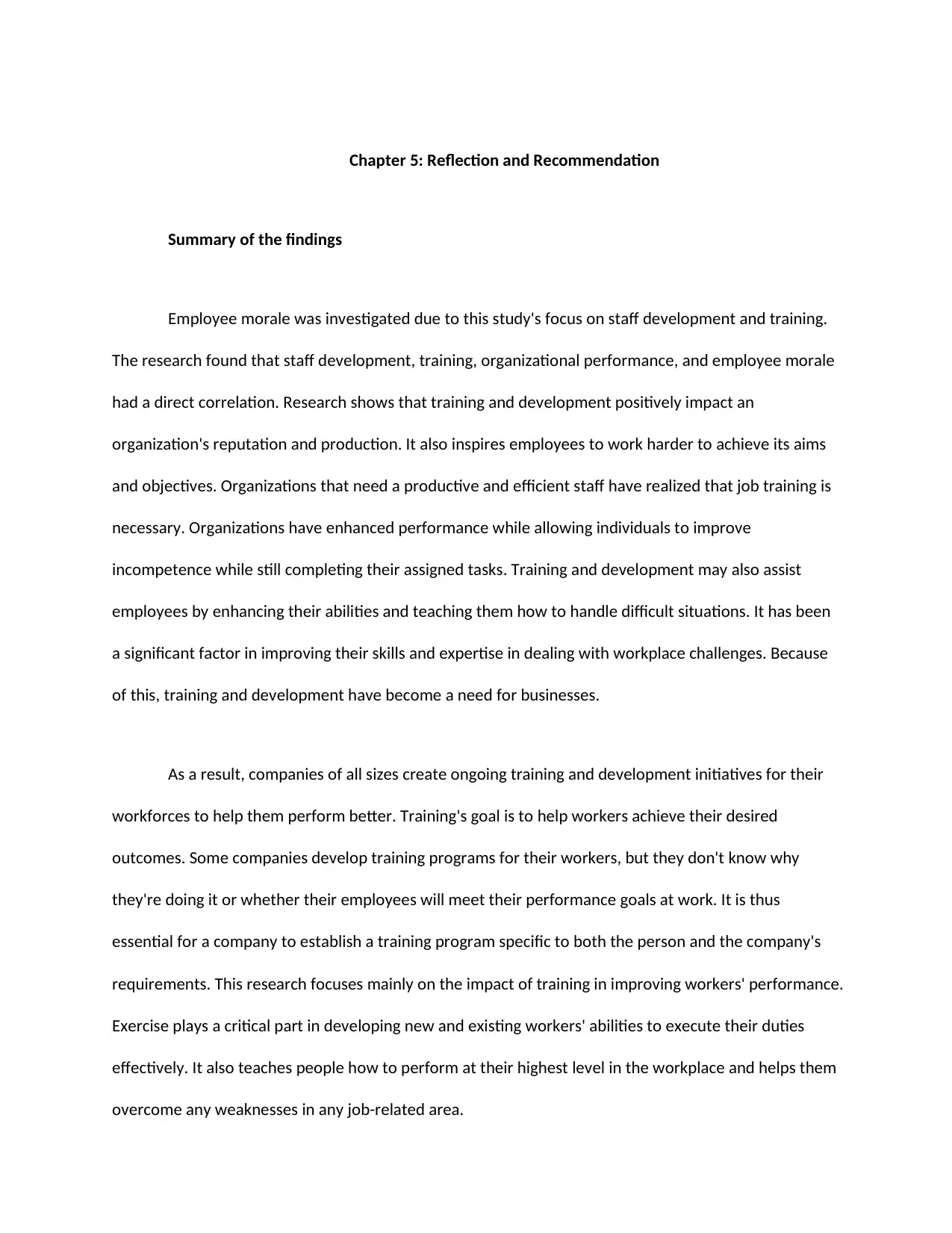
Chapter 5: Reflection and Recommendation
Summary of the findings
Employee morale was investigated due to this study's focus on staff development and training.
The research found that staff development, training, organizational performance, and employee morale
had a direct correlation. Research shows that training and development positively impact an
organization's reputation and production. It also inspires employees to work harder to achieve its aims
and objectives. Organizations that need a productive and efficient staff have realized that job training is
necessary. Organizations have enhanced performance while allowing individuals to improve
incompetence while still completing their assigned tasks. Training and development may also assist
employees by enhancing their abilities and teaching them how to handle difficult situations. It has been
a significant factor in improving their skills and expertise in dealing with workplace challenges. Because
of this, training and development have become a need for businesses.
As a result, companies of all sizes create ongoing training and development initiatives for their
workforces to help them perform better. Training's goal is to help workers achieve their desired
outcomes. Some companies develop training programs for their workers, but they don't know why
they're doing it or whether their employees will meet their performance goals at work. It is thus
essential for a company to establish a training program specific to both the person and the company's
requirements. This research focuses mainly on the impact of training in improving workers' performance.
Exercise plays a critical part in developing new and existing workers' abilities to execute their duties
effectively. It also teaches people how to perform at their highest level in the workplace and helps them
overcome any weaknesses in any job-related area.
Summary of the findings
Employee morale was investigated due to this study's focus on staff development and training.
The research found that staff development, training, organizational performance, and employee morale
had a direct correlation. Research shows that training and development positively impact an
organization's reputation and production. It also inspires employees to work harder to achieve its aims
and objectives. Organizations that need a productive and efficient staff have realized that job training is
necessary. Organizations have enhanced performance while allowing individuals to improve
incompetence while still completing their assigned tasks. Training and development may also assist
employees by enhancing their abilities and teaching them how to handle difficult situations. It has been
a significant factor in improving their skills and expertise in dealing with workplace challenges. Because
of this, training and development have become a need for businesses.
As a result, companies of all sizes create ongoing training and development initiatives for their
workforces to help them perform better. Training's goal is to help workers achieve their desired
outcomes. Some companies develop training programs for their workers, but they don't know why
they're doing it or whether their employees will meet their performance goals at work. It is thus
essential for a company to establish a training program specific to both the person and the company's
requirements. This research focuses mainly on the impact of training in improving workers' performance.
Exercise plays a critical part in developing new and existing workers' abilities to execute their duties
effectively. It also teaches people how to perform at their highest level in the workplace and helps them
overcome any weaknesses in any job-related area.
Paraphrase This Document
Need a fresh take? Get an instant paraphrase of this document with our AI Paraphraser
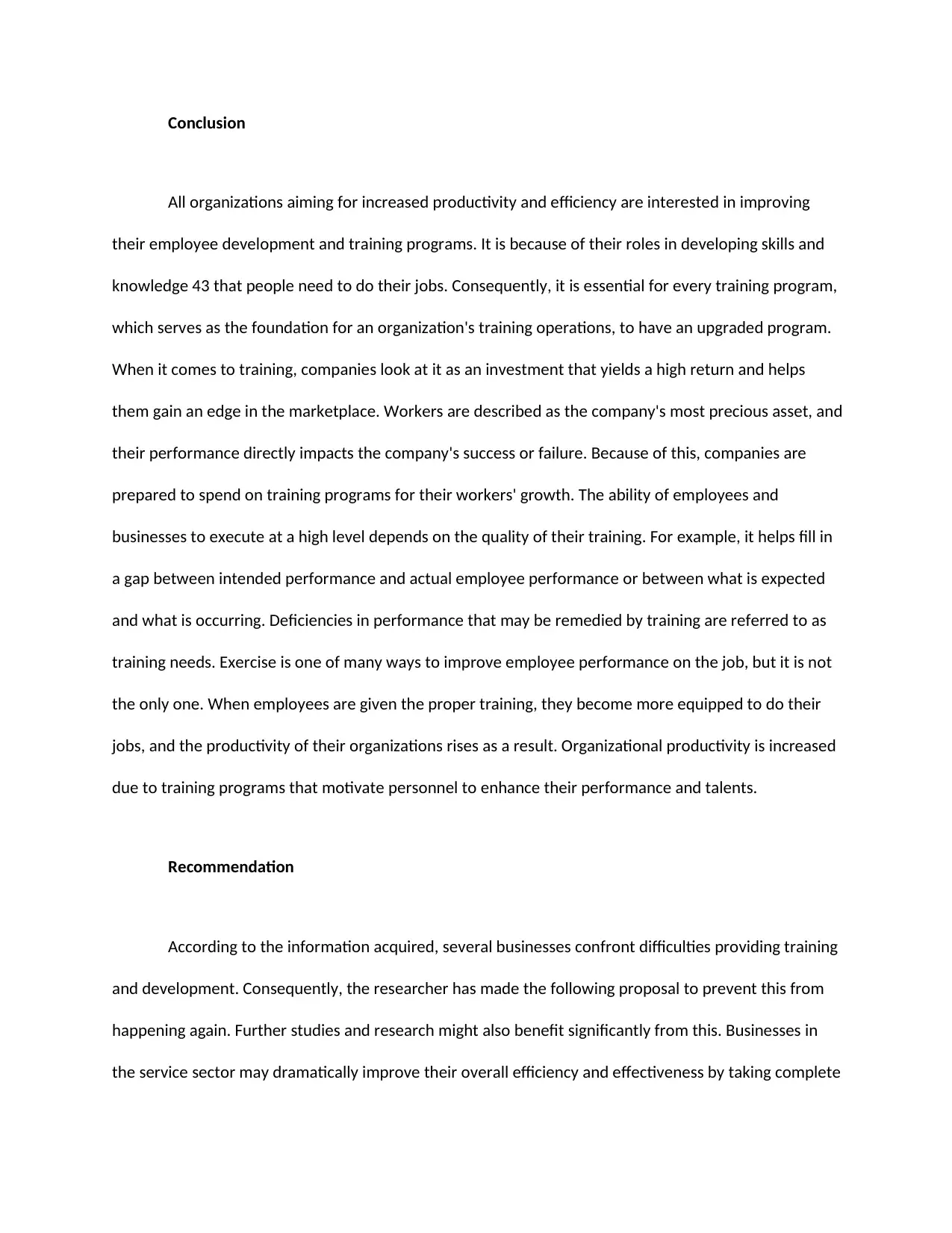
Conclusion
All organizations aiming for increased productivity and efficiency are interested in improving
their employee development and training programs. It is because of their roles in developing skills and
knowledge 43 that people need to do their jobs. Consequently, it is essential for every training program,
which serves as the foundation for an organization's training operations, to have an upgraded program.
When it comes to training, companies look at it as an investment that yields a high return and helps
them gain an edge in the marketplace. Workers are described as the company's most precious asset, and
their performance directly impacts the company's success or failure. Because of this, companies are
prepared to spend on training programs for their workers' growth. The ability of employees and
businesses to execute at a high level depends on the quality of their training. For example, it helps fill in
a gap between intended performance and actual employee performance or between what is expected
and what is occurring. Deficiencies in performance that may be remedied by training are referred to as
training needs. Exercise is one of many ways to improve employee performance on the job, but it is not
the only one. When employees are given the proper training, they become more equipped to do their
jobs, and the productivity of their organizations rises as a result. Organizational productivity is increased
due to training programs that motivate personnel to enhance their performance and talents.
Recommendation
According to the information acquired, several businesses confront difficulties providing training
and development. Consequently, the researcher has made the following proposal to prevent this from
happening again. Further studies and research might also benefit significantly from this. Businesses in
the service sector may dramatically improve their overall efficiency and effectiveness by taking complete
All organizations aiming for increased productivity and efficiency are interested in improving
their employee development and training programs. It is because of their roles in developing skills and
knowledge 43 that people need to do their jobs. Consequently, it is essential for every training program,
which serves as the foundation for an organization's training operations, to have an upgraded program.
When it comes to training, companies look at it as an investment that yields a high return and helps
them gain an edge in the marketplace. Workers are described as the company's most precious asset, and
their performance directly impacts the company's success or failure. Because of this, companies are
prepared to spend on training programs for their workers' growth. The ability of employees and
businesses to execute at a high level depends on the quality of their training. For example, it helps fill in
a gap between intended performance and actual employee performance or between what is expected
and what is occurring. Deficiencies in performance that may be remedied by training are referred to as
training needs. Exercise is one of many ways to improve employee performance on the job, but it is not
the only one. When employees are given the proper training, they become more equipped to do their
jobs, and the productivity of their organizations rises as a result. Organizational productivity is increased
due to training programs that motivate personnel to enhance their performance and talents.
Recommendation
According to the information acquired, several businesses confront difficulties providing training
and development. Consequently, the researcher has made the following proposal to prevent this from
happening again. Further studies and research might also benefit significantly from this. Businesses in
the service sector may dramatically improve their overall efficiency and effectiveness by taking complete

control of the need for and benefits of employee training and development inside their business.
However, the organization's instructional goals and objectives may be met using this method.
The future of employee training and development has culminated in an entrenched generation
for the younger generation. The next generation will be well-prepared for their careers thanks to their
education. Additionally, one facet of corporate training and development that is expected to become
standard is work-based learning. Organizations will implement it as an obligatory practice because of the
many advantages and critical components of employee training. From this perspective, an organization's
future training and development needs may be predicted. Evaluating an organization's bottom line has
been aided through personnel training and development. A company's profitability may rise by up to
29% when employing adequately trained individuals instead of those who lack such training. Several
studies have shown that providing workers with ongoing education and training may boost productivity
by 10% or more.
Training and development of workers are seen as an innovative notion that shows how
important it is for firms to achieve their business goals. It was thought that keeping staff was more cost-
effective than employing new ones in the past. As a result, an organization's expenditures are reduced by
educating and developing current personnel rather than acquiring new ones. Employee turnover is
expensive and hurts the bottom line of the company. As a result, the company saves money by retaining
and developing its present workforce via training and development. Retaining staff also allows firms to
maintain a team that has already been used to the dynamic nature of the job they conduct. In addition,
it has created a sense of uniformity in the work that people do. The researcher's ultimate goal in doing
this study was to serve as a foundation for future educational research, and he hopes that the firms he
works with would continue to teach their employees in this manner.
However, the organization's instructional goals and objectives may be met using this method.
The future of employee training and development has culminated in an entrenched generation
for the younger generation. The next generation will be well-prepared for their careers thanks to their
education. Additionally, one facet of corporate training and development that is expected to become
standard is work-based learning. Organizations will implement it as an obligatory practice because of the
many advantages and critical components of employee training. From this perspective, an organization's
future training and development needs may be predicted. Evaluating an organization's bottom line has
been aided through personnel training and development. A company's profitability may rise by up to
29% when employing adequately trained individuals instead of those who lack such training. Several
studies have shown that providing workers with ongoing education and training may boost productivity
by 10% or more.
Training and development of workers are seen as an innovative notion that shows how
important it is for firms to achieve their business goals. It was thought that keeping staff was more cost-
effective than employing new ones in the past. As a result, an organization's expenditures are reduced by
educating and developing current personnel rather than acquiring new ones. Employee turnover is
expensive and hurts the bottom line of the company. As a result, the company saves money by retaining
and developing its present workforce via training and development. Retaining staff also allows firms to
maintain a team that has already been used to the dynamic nature of the job they conduct. In addition,
it has created a sense of uniformity in the work that people do. The researcher's ultimate goal in doing
this study was to serve as a foundation for future educational research, and he hopes that the firms he
works with would continue to teach their employees in this manner.
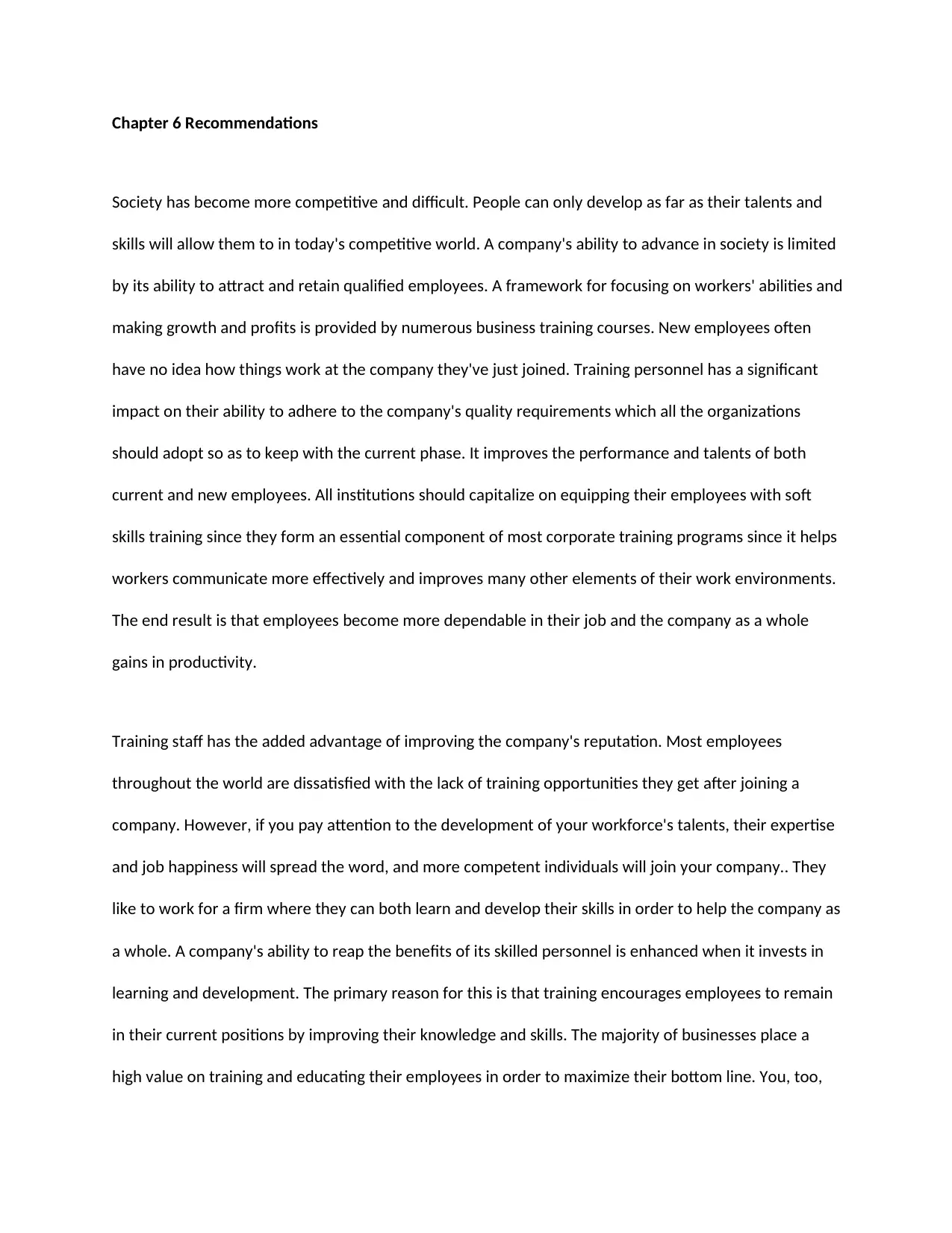
Chapter 6 Recommendations
Society has become more competitive and difficult. People can only develop as far as their talents and
skills will allow them to in today's competitive world. A company's ability to advance in society is limited
by its ability to attract and retain qualified employees. A framework for focusing on workers' abilities and
making growth and profits is provided by numerous business training courses. New employees often
have no idea how things work at the company they've just joined. Training personnel has a significant
impact on their ability to adhere to the company's quality requirements which all the organizations
should adopt so as to keep with the current phase. It improves the performance and talents of both
current and new employees. All institutions should capitalize on equipping their employees with soft
skills training since they form an essential component of most corporate training programs since it helps
workers communicate more effectively and improves many other elements of their work environments.
The end result is that employees become more dependable in their job and the company as a whole
gains in productivity.
Training staff has the added advantage of improving the company's reputation. Most employees
throughout the world are dissatisfied with the lack of training opportunities they get after joining a
company. However, if you pay attention to the development of your workforce's talents, their expertise
and job happiness will spread the word, and more competent individuals will join your company.. They
like to work for a firm where they can both learn and develop their skills in order to help the company as
a whole. A company's ability to reap the benefits of its skilled personnel is enhanced when it invests in
learning and development. The primary reason for this is that training encourages employees to remain
in their current positions by improving their knowledge and skills. The majority of businesses place a
high value on training and educating their employees in order to maximize their bottom line. You, too,
Society has become more competitive and difficult. People can only develop as far as their talents and
skills will allow them to in today's competitive world. A company's ability to advance in society is limited
by its ability to attract and retain qualified employees. A framework for focusing on workers' abilities and
making growth and profits is provided by numerous business training courses. New employees often
have no idea how things work at the company they've just joined. Training personnel has a significant
impact on their ability to adhere to the company's quality requirements which all the organizations
should adopt so as to keep with the current phase. It improves the performance and talents of both
current and new employees. All institutions should capitalize on equipping their employees with soft
skills training since they form an essential component of most corporate training programs since it helps
workers communicate more effectively and improves many other elements of their work environments.
The end result is that employees become more dependable in their job and the company as a whole
gains in productivity.
Training staff has the added advantage of improving the company's reputation. Most employees
throughout the world are dissatisfied with the lack of training opportunities they get after joining a
company. However, if you pay attention to the development of your workforce's talents, their expertise
and job happiness will spread the word, and more competent individuals will join your company.. They
like to work for a firm where they can both learn and develop their skills in order to help the company as
a whole. A company's ability to reap the benefits of its skilled personnel is enhanced when it invests in
learning and development. The primary reason for this is that training encourages employees to remain
in their current positions by improving their knowledge and skills. The majority of businesses place a
high value on training and educating their employees in order to maximize their bottom line. You, too,
Secure Best Marks with AI Grader
Need help grading? Try our AI Grader for instant feedback on your assignments.

may join the ranks of these firms, ensuring a better reputation for your business in the community. The
revenues of a firm may be increased by ensuring that its employees have the necessary skills and talents.
A member of the workforce in a company's ability to rise through the ranks is enhanced through training
and education hence institutions should take the advantage of empowering their staff base by employing
these strategies. When it comes to corporate training and development, the goal is to ensure that the
company has the best and brightest employees possible. To think of staff training as a waste of time and
money is a mistake. This is an investment in the long-term health of the company, regardless of the
expenditures involved. Providing your employees with the chance to learn new things is a direct
investment in their future. Motivated employees are also more productive, efficient, and loyal. Investing
in an institutions education and training will pay dividends in the long run. A company's ability to keep
up with industry developments depends on providing regular training and development opportunities
for its personnel and its business. In order to stand out from the crowd when applying for higher-level
roles, employees should participate in training and development opportunities. Businesses have every
potential to surpass their rivals if they invest in a well-trained and well-capable personnel.
Chapter 7
This chapter will develop and discuss models that aid in employee development that lead to
organizational benefit. Besides, the model's implications and impact will also be analyzed. The model
consists of job experiences, assessments, interpersonal relationships, and formal education (Hezlett &
McCauley, 2018).
revenues of a firm may be increased by ensuring that its employees have the necessary skills and talents.
A member of the workforce in a company's ability to rise through the ranks is enhanced through training
and education hence institutions should take the advantage of empowering their staff base by employing
these strategies. When it comes to corporate training and development, the goal is to ensure that the
company has the best and brightest employees possible. To think of staff training as a waste of time and
money is a mistake. This is an investment in the long-term health of the company, regardless of the
expenditures involved. Providing your employees with the chance to learn new things is a direct
investment in their future. Motivated employees are also more productive, efficient, and loyal. Investing
in an institutions education and training will pay dividends in the long run. A company's ability to keep
up with industry developments depends on providing regular training and development opportunities
for its personnel and its business. In order to stand out from the crowd when applying for higher-level
roles, employees should participate in training and development opportunities. Businesses have every
potential to surpass their rivals if they invest in a well-trained and well-capable personnel.
Chapter 7
This chapter will develop and discuss models that aid in employee development that lead to
organizational benefit. Besides, the model's implications and impact will also be analyzed. The model
consists of job experiences, assessments, interpersonal relationships, and formal education (Hezlett &
McCauley, 2018).

Job experiences Assessments
Interpersonal
relationships
Formal education.
Formal education
Organizations may help employees grow by providing formal education programs on-site or off-
site. Executive MBA programs allow managers to get a master's degree in business administration on the
weekends or at night. Expert lectures, business games & simulations, experiential exercises, and
customer meetings are all possibilities in these programs. Most of these training strategies were
discussed. Several corporations offer seminars and longer-term programs, such as the Bank of Montreal
and General Electric (Dachner et al., 2021). A classroom, a presentation hall, and lodging for out-of-town
personnel are available at the Bank of Montreal Institute for Learning. Programs include managerial
leadership, risk management, project management, and MBA courses. All educational institutions, public
and private, provide executive education. Employers and education providers create short courses with
material tailored to the audience. Participants in small groups work on class assignments and provide
suggestions to corporate management.
Assessments
Interpersonal
relationships
Formal education.
Formal education
Organizations may help employees grow by providing formal education programs on-site or off-
site. Executive MBA programs allow managers to get a master's degree in business administration on the
weekends or at night. Expert lectures, business games & simulations, experiential exercises, and
customer meetings are all possibilities in these programs. Most of these training strategies were
discussed. Several corporations offer seminars and longer-term programs, such as the Bank of Montreal
and General Electric (Dachner et al., 2021). A classroom, a presentation hall, and lodging for out-of-town
personnel are available at the Bank of Montreal Institute for Learning. Programs include managerial
leadership, risk management, project management, and MBA courses. All educational institutions, public
and private, provide executive education. Employers and education providers create short courses with
material tailored to the audience. Participants in small groups work on class assignments and provide
suggestions to corporate management.
Assessments
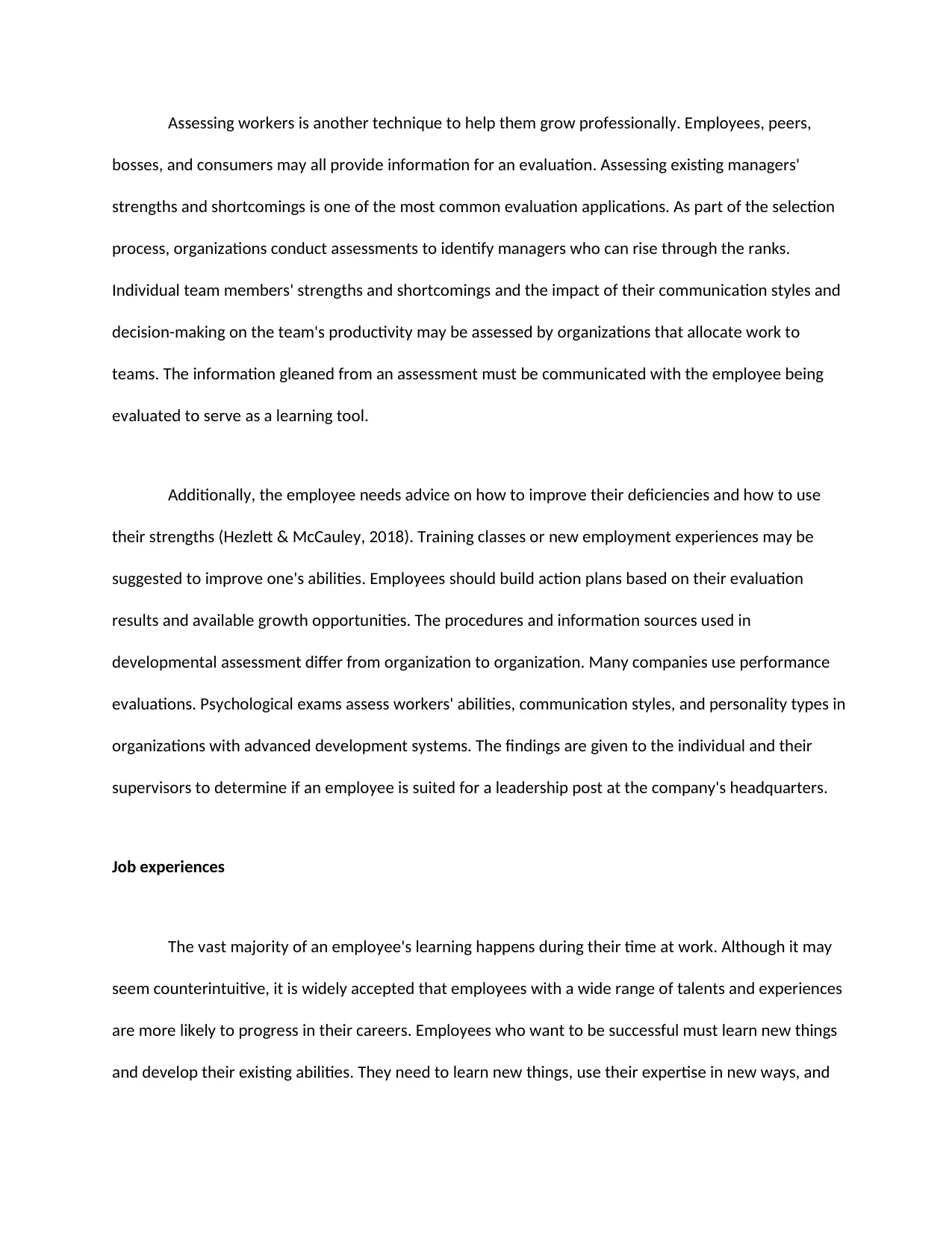
Assessing workers is another technique to help them grow professionally. Employees, peers,
bosses, and consumers may all provide information for an evaluation. Assessing existing managers'
strengths and shortcomings is one of the most common evaluation applications. As part of the selection
process, organizations conduct assessments to identify managers who can rise through the ranks.
Individual team members' strengths and shortcomings and the impact of their communication styles and
decision-making on the team's productivity may be assessed by organizations that allocate work to
teams. The information gleaned from an assessment must be communicated with the employee being
evaluated to serve as a learning tool.
Additionally, the employee needs advice on how to improve their deficiencies and how to use
their strengths (Hezlett & McCauley, 2018). Training classes or new employment experiences may be
suggested to improve one's abilities. Employees should build action plans based on their evaluation
results and available growth opportunities. The procedures and information sources used in
developmental assessment differ from organization to organization. Many companies use performance
evaluations. Psychological exams assess workers' abilities, communication styles, and personality types in
organizations with advanced development systems. The findings are given to the individual and their
supervisors to determine if an employee is suited for a leadership post at the company's headquarters.
Job experiences
The vast majority of an employee's learning happens during their time at work. Although it may
seem counterintuitive, it is widely accepted that employees with a wide range of talents and experiences
are more likely to progress in their careers. Employees who want to be successful must learn new things
and develop their existing abilities. They need to learn new things, use their expertise in new ways, and
bosses, and consumers may all provide information for an evaluation. Assessing existing managers'
strengths and shortcomings is one of the most common evaluation applications. As part of the selection
process, organizations conduct assessments to identify managers who can rise through the ranks.
Individual team members' strengths and shortcomings and the impact of their communication styles and
decision-making on the team's productivity may be assessed by organizations that allocate work to
teams. The information gleaned from an assessment must be communicated with the employee being
evaluated to serve as a learning tool.
Additionally, the employee needs advice on how to improve their deficiencies and how to use
their strengths (Hezlett & McCauley, 2018). Training classes or new employment experiences may be
suggested to improve one's abilities. Employees should build action plans based on their evaluation
results and available growth opportunities. The procedures and information sources used in
developmental assessment differ from organization to organization. Many companies use performance
evaluations. Psychological exams assess workers' abilities, communication styles, and personality types in
organizations with advanced development systems. The findings are given to the individual and their
supervisors to determine if an employee is suited for a leadership post at the company's headquarters.
Job experiences
The vast majority of an employee's learning happens during their time at work. Although it may
seem counterintuitive, it is widely accepted that employees with a wide range of talents and experiences
are more likely to progress in their careers. Employees who want to be successful must learn new things
and develop their existing abilities. They need to learn new things, use their expertise in new ways, and
Paraphrase This Document
Need a fresh take? Get an instant paraphrase of this document with our AI Paraphraser
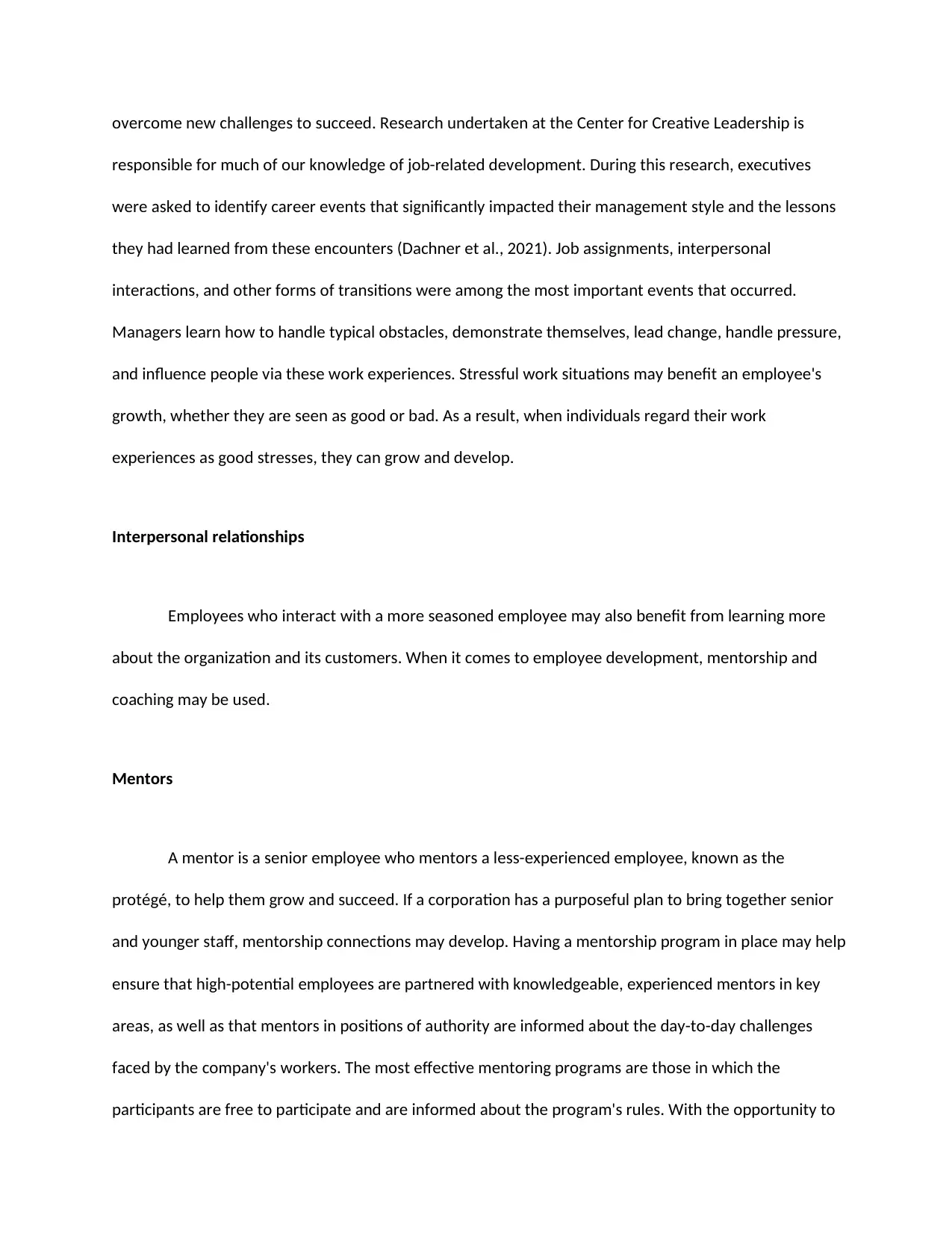
overcome new challenges to succeed. Research undertaken at the Center for Creative Leadership is
responsible for much of our knowledge of job-related development. During this research, executives
were asked to identify career events that significantly impacted their management style and the lessons
they had learned from these encounters (Dachner et al., 2021). Job assignments, interpersonal
interactions, and other forms of transitions were among the most important events that occurred.
Managers learn how to handle typical obstacles, demonstrate themselves, lead change, handle pressure,
and influence people via these work experiences. Stressful work situations may benefit an employee's
growth, whether they are seen as good or bad. As a result, when individuals regard their work
experiences as good stresses, they can grow and develop.
Interpersonal relationships
Employees who interact with a more seasoned employee may also benefit from learning more
about the organization and its customers. When it comes to employee development, mentorship and
coaching may be used.
Mentors
A mentor is a senior employee who mentors a less-experienced employee, known as the
protégé, to help them grow and succeed. If a corporation has a purposeful plan to bring together senior
and younger staff, mentorship connections may develop. Having a mentorship program in place may help
ensure that high-potential employees are partnered with knowledgeable, experienced mentors in key
areas, as well as that mentors in positions of authority are informed about the day-to-day challenges
faced by the company's workers. The most effective mentoring programs are those in which the
participants are free to participate and are informed about the program's rules. With the opportunity to
responsible for much of our knowledge of job-related development. During this research, executives
were asked to identify career events that significantly impacted their management style and the lessons
they had learned from these encounters (Dachner et al., 2021). Job assignments, interpersonal
interactions, and other forms of transitions were among the most important events that occurred.
Managers learn how to handle typical obstacles, demonstrate themselves, lead change, handle pressure,
and influence people via these work experiences. Stressful work situations may benefit an employee's
growth, whether they are seen as good or bad. As a result, when individuals regard their work
experiences as good stresses, they can grow and develop.
Interpersonal relationships
Employees who interact with a more seasoned employee may also benefit from learning more
about the organization and its customers. When it comes to employee development, mentorship and
coaching may be used.
Mentors
A mentor is a senior employee who mentors a less-experienced employee, known as the
protégé, to help them grow and succeed. If a corporation has a purposeful plan to bring together senior
and younger staff, mentorship connections may develop. Having a mentorship program in place may help
ensure that high-potential employees are partnered with knowledgeable, experienced mentors in key
areas, as well as that mentors in positions of authority are informed about the day-to-day challenges
faced by the company's workers. The most effective mentoring programs are those in which the
participants are free to participate and are informed about the program's rules. With the opportunity to
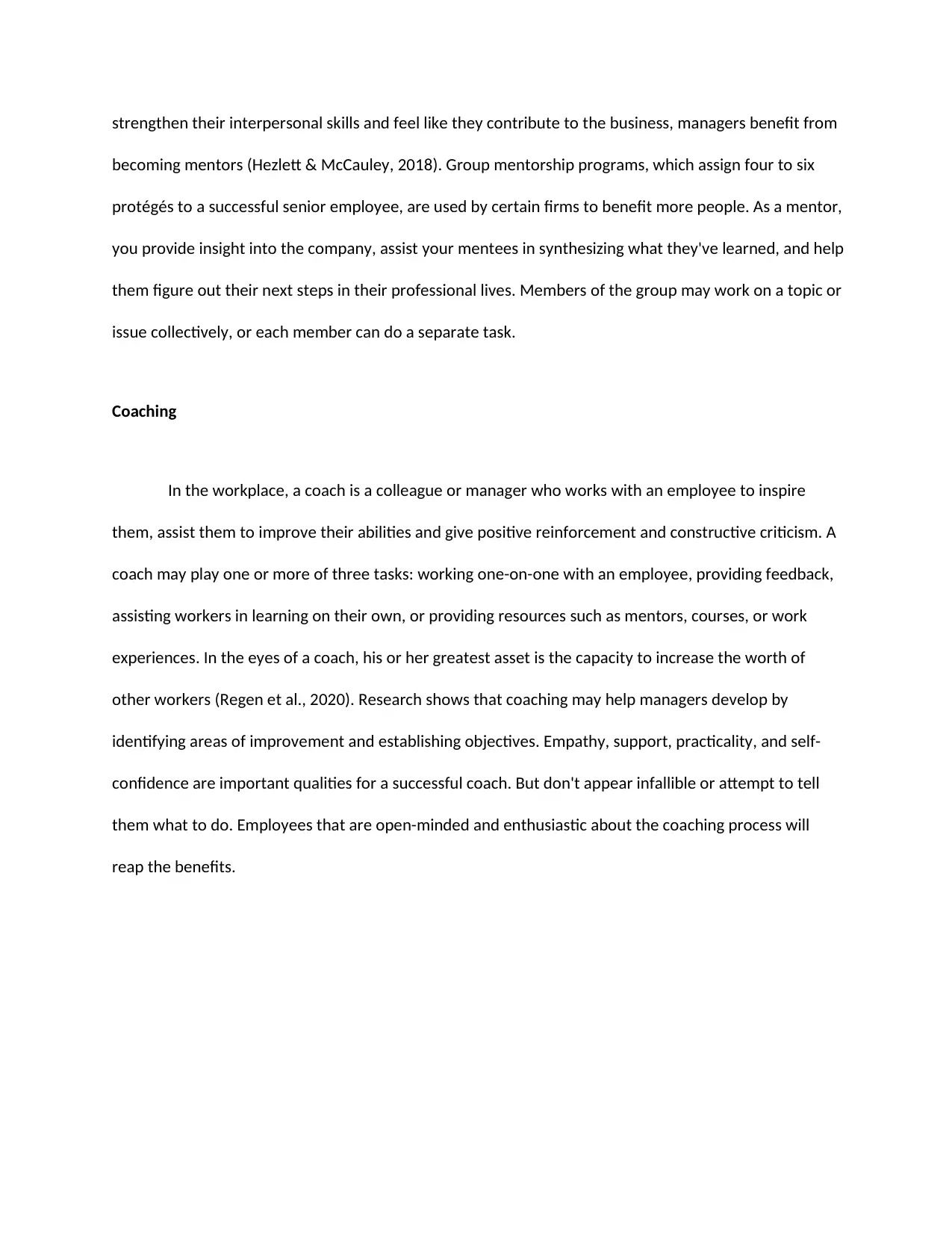
strengthen their interpersonal skills and feel like they contribute to the business, managers benefit from
becoming mentors (Hezlett & McCauley, 2018). Group mentorship programs, which assign four to six
protégés to a successful senior employee, are used by certain firms to benefit more people. As a mentor,
you provide insight into the company, assist your mentees in synthesizing what they've learned, and help
them figure out their next steps in their professional lives. Members of the group may work on a topic or
issue collectively, or each member can do a separate task.
Coaching
In the workplace, a coach is a colleague or manager who works with an employee to inspire
them, assist them to improve their abilities and give positive reinforcement and constructive criticism. A
coach may play one or more of three tasks: working one-on-one with an employee, providing feedback,
assisting workers in learning on their own, or providing resources such as mentors, courses, or work
experiences. In the eyes of a coach, his or her greatest asset is the capacity to increase the worth of
other workers (Regen et al., 2020). Research shows that coaching may help managers develop by
identifying areas of improvement and establishing objectives. Empathy, support, practicality, and self-
confidence are important qualities for a successful coach. But don't appear infallible or attempt to tell
them what to do. Employees that are open-minded and enthusiastic about the coaching process will
reap the benefits.
becoming mentors (Hezlett & McCauley, 2018). Group mentorship programs, which assign four to six
protégés to a successful senior employee, are used by certain firms to benefit more people. As a mentor,
you provide insight into the company, assist your mentees in synthesizing what they've learned, and help
them figure out their next steps in their professional lives. Members of the group may work on a topic or
issue collectively, or each member can do a separate task.
Coaching
In the workplace, a coach is a colleague or manager who works with an employee to inspire
them, assist them to improve their abilities and give positive reinforcement and constructive criticism. A
coach may play one or more of three tasks: working one-on-one with an employee, providing feedback,
assisting workers in learning on their own, or providing resources such as mentors, courses, or work
experiences. In the eyes of a coach, his or her greatest asset is the capacity to increase the worth of
other workers (Regen et al., 2020). Research shows that coaching may help managers develop by
identifying areas of improvement and establishing objectives. Empathy, support, practicality, and self-
confidence are important qualities for a successful coach. But don't appear infallible or attempt to tell
them what to do. Employees that are open-minded and enthusiastic about the coaching process will
reap the benefits.
1 out of 33
Related Documents
Your All-in-One AI-Powered Toolkit for Academic Success.
+13062052269
info@desklib.com
Available 24*7 on WhatsApp / Email
![[object Object]](/_next/static/media/star-bottom.7253800d.svg)
Unlock your academic potential
© 2024 | Zucol Services PVT LTD | All rights reserved.





